
94% of researchers rate our articles as excellent or good
Learn more about the work of our research integrity team to safeguard the quality of each article we publish.
Find out more
ORIGINAL RESEARCH article
Front. Earth Sci., 17 March 2025
Sec. Geochemistry
Volume 13 - 2025 | https://doi.org/10.3389/feart.2025.1558360
This article is part of the Research TopicShale Oil Micro-Migration and Its Effect on Shale Oil Differential EnrichmentView all 7 articles
Hybrid sedimentary shales (HSS) are key components of continental shale oil resources. The inherent heterogeneity of HSS lead to rapid variations in oil content and mobility, complicating sweet spot prediction. Previous studies have classified HSS lithofacies and assessed oil content. However, favourable lithofacies for oil content and mobility remains debated. This study classified the Shahejie Formation HSS from the Dongpu Depression, Bohai Bay Basin into massive argillaceous shale (Lithofacies I), bedded argillaceous shale (Lithofacies II), and laminated calcareous shale (Lithofacies III) based on sedimentary texture, mineral composition, and total organic carbon (TOC) content. The light hydrocarbon calibrated oil content (S1C), oil mobility (OSI), and micro-migration hydrocarbon content (δQ) variations among these lithofacies were conducted to determine favourable oil content and mobility lithofacies. Results show that the Lithofacies III exhibited the highest average TOC (1.56 w. t. %), hydrogen index (HI) (264 mg/g TOC), oil content (S1C = 1.81 mg/g), and oil mobility (OSI = 188 mg/g TOC). Geochemical data revealed that Lithofacies III also display the most pronounced micro-migration (average δQ = −138 mg/g TOC). TOC, Tmax, and δQ influence the oil content of HSS, with TOC being the primary factor, suggesting that shales with high organic matter abundance possess better hydrocarbon generation potential and can produce more shale oil. Conversely, δQ, clay minerals, and carbonate minerals affect oil mobility, with δQ being the dominant factor, highlighting the role of micro-migration in pore connectivity, transport, and enrichment of shale oil within the extramicro-migration and intramicro-migration units. Global comparisons show that micro-migration drives HSS oil enrichment, while sedimentary environment and tectonic setting influence oil content and mobility. This study provides new insights into key factors controlling HSS oil micro-migration and enrichment, advancing global exploration and development of HSS resources.
The successful shale oil exploration and development in the United States has established it as a global hotspot for unconventional oil and gas resources (Glikson-Simpson, 2021; Minna et al., 2021; Emmanuel et al., 2022; Xu et al., 2024). As shale oil and gas become increasingly viable, more companies are investing in shale oil exploration (Bernard et al., 2012a; 2012b; Milliken et al., 2012; Zou et al., 2013; Wang et al., 2021). Above them, hybrid sedimentary shales (HSS) are composed of clastic, clay, and biogenic components, formed in complex sedimentary environments (Zhou et al., 2023; Zhang et al., 2021; Hu et al., 2024a; Wei et al., 2024). Globally distributed, HSS are particularly prominent in the Delaware and Midland Basins in the United States, the Papua Basin in Australia, and the North Sea Basin in Europe (Haughton et al., 2009; Luo et al., 2012; Liu, 2022). HSS oil constitutes a significant composition of shale oil resources (Edgell, 1996; Hudec and Jackson, 2006; Jiang et al., 2022; Wang et al., 2022a). High organic-rich HSS formations include the Eagle Ford Shale (Altawati et al., 2021), Wolfcamp shale in the Permian Basin (Zumberge et al., 2017; Curtis and Zumberge, 2018), Vaca Muerta Formation in Argentina (Stinco and Barredo, 2014), Yanchang Formation in the Ordos Basin (Wang et al., 2024), and the Shahejie Formation in the Jiyang Depression (Teng et al., 2022). In contrast, medium-to low-organic-rich formations include the Fengcheng Formation of the Mahu Sag, Junggar Basin (Jiang et al., 2023a; Hu et al., 2024a), the Ganchaigou Formation in the Qaidam Basin (Li et al., 2022; Song et al., 2024), and the Shahejie Formation in the Dongying Depression, Bohai Bay Basin (Jiang et al., 2022; Wang et al., 2022b). The stratigraphy of HSS reflects complex sedimentary environments, resulting in considerable heterogeneity in shale reservoirs. The kerogen types and organic matter abundance in organic-rich laminae significantly control hydrocarbon generation potential (Gao et al., 2009; Eyong et al., 2018; Milkov et al., 2020; Yakubov et al., 2020), while inorganic mineral composition grovens oil occurrence. Variations in sedimentary conditions impact density and thickness, thus controlling the distribution of sweet spots. Consequently, vertical variations in oil content and mobility are common in HSS (Gharib et al., 2024; He et al., 2024). Furthermore, the presence of salt minerals in lacustrine basins enhances the hydrocarbon generation and storage capacity compared to freshwater basins (Wu et al., 2023), further complicating sweet spot prediction and resource potential evaluation.
Early shale lithofacies classifications were qualitative, relying on core descriptions and thin-section observations (Loucks and Ruppel, 2007; Loucks et al., 2009; Liu et al., 2017; Williams et al., 2022). Contemporary classifications have evolved to quantitative proxies, such as mineral composition, sedimentary textures, and organic matter abundance (Potter and Longstaffe, 2007; Potter et al., 2020; Hamlin and Baumgardner, 2012; Shi et al., 2020; Pan et al., 2022). Previous studies have classified HSS lithofacies and characterized shale types (Ko et al., 2016; Jin et al., 2019; Kuang et al., 2021; Gao et al., 2022), yet the favourable lithofacies for oil content and mobility remains debated. Recent investigations have highlighted significant micro-migration phenomena in HSS (Hu et al., 2024a; Hu et al., 2024b; Hu et al., 2025; Rudra et al., 2024; Wu et al., 2024a), which play a critical role in hydrocarbon generation capacity, storage capacity, and preservation conditions (Yurchenko et al., 2018; Liu et al., 2022; Liu et al., 2023; Zhang et al., 2024). Previous studies have Micro-migration has been identified through geochemical anomalies, and quantitative models for evaluating micro-migrated hydrocarbons have been established (Liu et al., 2023; Hu et al., 2024a; Hu et al., 2024b). Applying this method to HSS can improve the accuracy of sweet spot predictions.
As a representative HSS formation, the third member of the Shahejie Formation in the Dongpu Depression (DD) is rich in oil and gas resources. This study systematically classified the lithofacies based on sedimentary textures, mineral composition, and total organic carbon (TOC) content. Geochemical analyses and micro-migration evaluations were conducted to reveal hydrocarbon generation potential, oil content, and mobility variations across lithofacies. The controlling factors for oil content and mobility were determined through microscopic observations and Pearson correlation analysis. Moreover, we compare favourable HSS lithofacies for oil content and mobility in the Dongpu Depression with the Mahu Depression in China and the Delaware and Midland Basins in the United States, highlighting the potential for global HSS oil resource exploration and development. This study provides theoretical foundations and new perspectives for the exploration of HSS oil resources.
The DD in the Bohai Bay Basin, located in the southern part of the Bohai Bay Basin in China, is a part of the Linqing Depression, situated in the southeastern portion of the Linqing Depression (Su et al., 2006). It is bordered to the east by the Lanliao Fault and the Luxi Uplift, overlies the Neihuang Uplift to the west, faces the Lankao Uplift and Kaifeng Depression to the south across, and connects to the Shenxian Depression via the Malang Fault to the north (Jiang et al., 2022; Zhu et al., 2021; Wu et al., 2023). The depression trends north-northeast, narrower in the north and wider in the south, covering an area of approximately 5,300 km2 (Figures 1A, B).
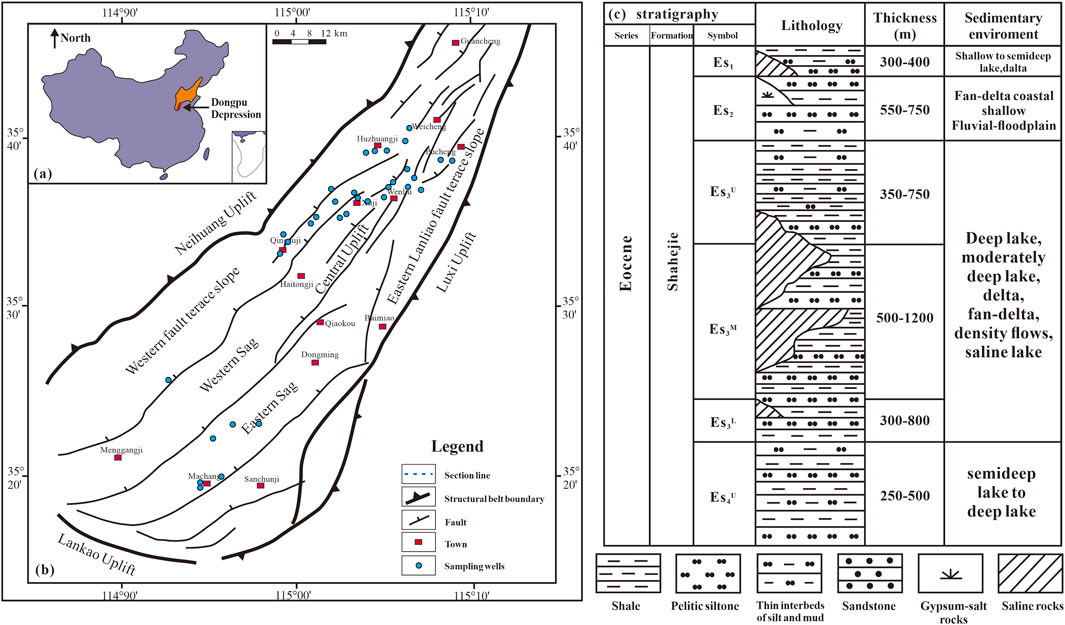
Figure 1. (A) The location of the Bohai Bay Basin in China; (B) Structure map of the DD and location of sampling wells; (C) Generalized stratigraphy of the Dongpu Depression [Modified from Zhu et al. (2021) and Wu et al. (2023)].
The DD includes sedimentary formations ranging from the Paleogene Shahejie Formation (consisting of 4th, 3rd, 2nd, and 1st members) to the Dongying Formation. These formations are angularly unconformably overlain by the younger Cenozoic Guantao and Minghuazhen formations. Following Paleogene sedimentation, there was regional uplift and erosion before subsequent subsidence and deposition of the Neogene formations. There is also an angular unconformity between the Paleogene and Neogene sequences. The study focuses on the strata of the Shahejie Formation (Wu et al., 2024b) (Figure 1C).
This study analyzed 354 samples from 33 wells, employing a range of techniques including core observation, thin-section analysis, whole-rock X-ray diffraction (XRD), total organic carbon (TOC) analysis, pyrolysis, scanning electron microscopy (SEM), and elemental geochemical analysis. The experiments were conducted at the National Key Laboratory of Petroleum Resources and Engineering at China University of Petroleum and the Zhongyuan Oilfield Branch of SINOPEC.
For the TOC analysis, inorganic carbon was removed from the samples before testing with a LECO CS-230 carbon-sulfur analyzer. The samples were subjected to heating at 300°C–600°C using a Rock-Eval II pyrolysis machine to obtain free hydrocarbons (S1, measured in mg HC/g Rock) and pyrolytic hydrocarbons (S2, also in mg HC/g Rock).
The analysis of major, trace, and rare earth elements required grinding the selected samples to a 200 mesh powder. The samples were dried for two hours in a constant temperature oven at 100°C, then cooled in a dryer. A 0.2,000 g sample was placed into a crucible, followed by the addition of 5 mL each of nitric acid, hydrofluoric acid, and perchloric acid. The sample was heated on an electric plate, gradually reaching over 200°C to remove impurities, then maintained at approximately 60°C for over three hours. After this, the sample was heated to 200°C, and aqua regia was added for extraction. The final extract was transferred to a 20 mL volumetric flask and diluted with water. Prepared samples were analyzed using ICP-MS and ICP-OES to determine the concentrations of major, trace, and rare earth elements.
For SEM observation, the cut samples were gold-coated and examined under a FEI Quanta 200 F scanning electron microscope, operated at 15 kV with an object distance of 10–12 mm.
The real hydrocarbon generation potential (HGPR) and the original hydrocarbon generation potential (HGPO), defined as δQ, were calculated using an established model specific to the DD. A δQ value greater than zero indicates that HGPO exceeds HGPR, characterizing hydrocarbon extramicro-migration (HEM), while a δQ value less than zero indicates that HGPO is less than HGPR, defining hydrocarbon intramicro-migration (HIM).
Significant loss of light hydrocarbons can occur during core preservation and sample preparation, leading to errors in the assessment of oil content (Zhang et al., 2014). Therefore, light hydrocarbon calibration is necessary prior to evaluating shale oil content to ascertain the actual oil saturation (Ross and Bustin, 2007). Light hydrocarbon calibration involved thermal simulation experiments on low-maturity samples of different kerogen types, based on the assumption that the proportions of hydrocarbon components between generated hydrocarbons and residual hydrocarbons remain consistent (Jiang et al., 2016). The calibration coefficient for light hydrocarbons (Klh) was calculated using the ratio of C1-14 to C14+. For detailed methodology, refer to Hu et al. (2024b) and Wu et al. (2024a).
Previous studies have classified the lithofacies of fine-grained rocks based on rock color, sedimentary textures, mineral composition, total organic carbon (TOC) content, and mechanical properties (Stow and Piper, 1984; Singh et al., 2009; Zhang et al., 2022; Lv et al., 2023). In this study, fine-grained sedimentary rocks are classified into three types, focusing on sedimentary textures, mineral composition, and TOC content.
Three sedimentary textures are identified in the continental shale: massive shale, bedded shale, and laminated shale (Figure 2). XRD results indicate that the primary mineral components include clay, quartz, feldspar, calcite, and dolomite, with trace amounts of gypsum, halite, and pyrite. Clay content varies from 3.45% to 74.7% (average: 34.4%), with 24% of the samples exceeding 50% clay. The felsic component (quartz + feldspar) ranges from 2.6% to 72.9% (average: 28.1%), with 17% of samples surpassing 50%. Carbonate content ranges from 1.2% to 84.8% (average: 27.3%), with 15% of samples exceeding 50%, primarily consisting of calcite, which ranges from 0.6% to 84.7% (average: 19.5%). In the 4th Member of the Shahejie Formation through to the 3rd Member in the DD, fine-grained rock types are predominantly gray massive-layered clay shales, dark-colored laminated lime-dolomite shales, and dark-colored lime-dolomite rocks. These are followed by dark-colored layered-massive clay shales and dark-colored laminated-massive clayey lime-dolomite shales.

Figure 2. The sedimentary textures of shales in the Dongpu Depression. (A) Massive structure, well Wei 4457HF, 3,683.85 m; (B) Layered structure, well Wei 457HF 3861.57 m; (C) Laminae structure, well P161 3,840.11 m.
For shales with TOC greater than 1 w. t. %, a ternary diagram of mineral composition for HSS was established. The fine-grained rock types identified in the DD include siliceous shale, argillaceous shale, calcareous shale, and mixed shale (Figure 3) (Wang et al., 2022c; Wang et al., 2025). These lithofacies types display specific correlations with sedimentary textures. Based on the mineral composition and microstructural characteristics, we identified three primary lithofacies (Figure 4). Lithofacies I: Massive argillaceous shale. This facies is characterized by a relatively uniform microstructure, indicating consistent sedimentation processes and minimal variation in composition (Figure 4A). Lithofacies II: Bedded argillaceous shale. This facies predominantly consists of clay minerals, with laminar fractures observed between the clay layers and clastic mineral layers. The presence of these fractures suggests a history of differential compaction or desiccation (Figure 4B). Lithofacies III: Laminated calcareous shale. This facies is primarily composed of alternating clay-rich and carbonate rock laminae, with laminae thickness ranging from 50 to 200 µm (Figure 4C). The distinct layering indicates episodic deposition and variations in sediment supply, likely influenced by environmental factors.
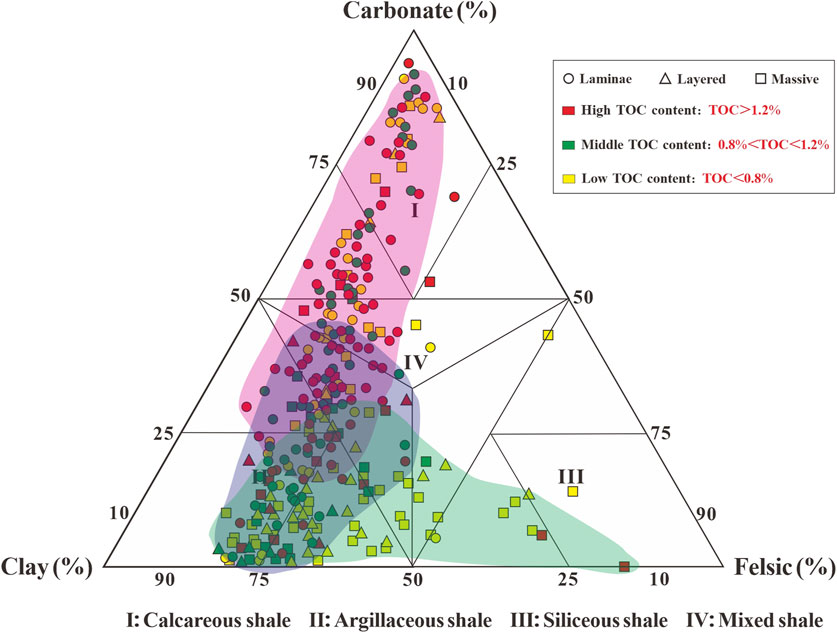
Figure 3. Mineral composition of Shahejie Formation, Dongpu Depression. Type I represents calcareous shale, type II represents argillaceous shale, type III represents siliceous shale, and type IV represents mixed shale. The red shadow part indicates the shale with high TOC content, the blue shadow indicates the shale with moderate TOC content, and the green shadow indicates the shale with low TOC content.
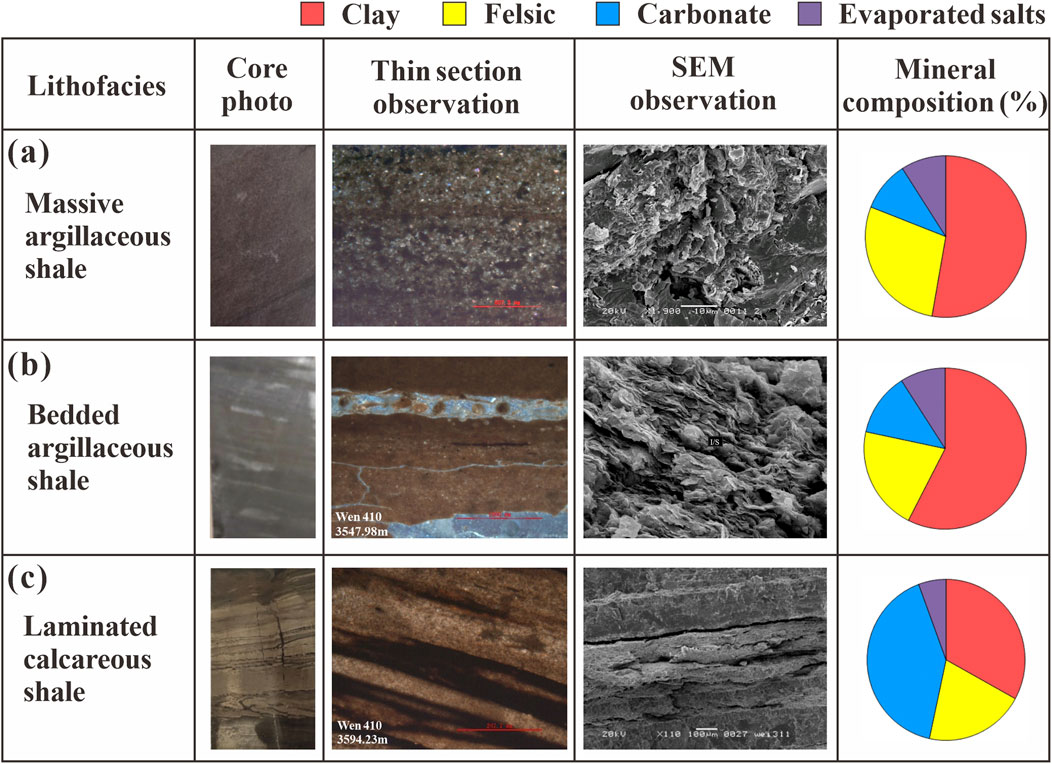
Figure 4. Core photos, thin section observations, SEM observations, and mineral composition for each lithofacies. (A) Massive argillaceous shale; (B) Bedded argillaceous shale; (C) Laminated calcareous shale.
The TOC contents of Lithofacies I (Figure 5A) range from 0.28–2.27 w. t. %, with an average of 0.78 w. t. % (Table 1). Most samples within this facies exhibit TOC values below 0.5 w. t. % (Figure 5D). The organic matter (OM) is primarily classified as Type III (Figure 5E), indicating a predominance of terrigenous organic matter that has reached a mature stage. Under fluorescence microscopy, the OM content is low, with only a few weakly fluorescent OM particles and some black higher plant debris observed (Figures 6A, B). Tmax ranges from 384°C–493°C, with an average of 424°C. Moreover, the average vitrinite reflectance (Ro) of Lithofacies I is 0.89, indicating that the Lithofacies I shale is in the mature stage.
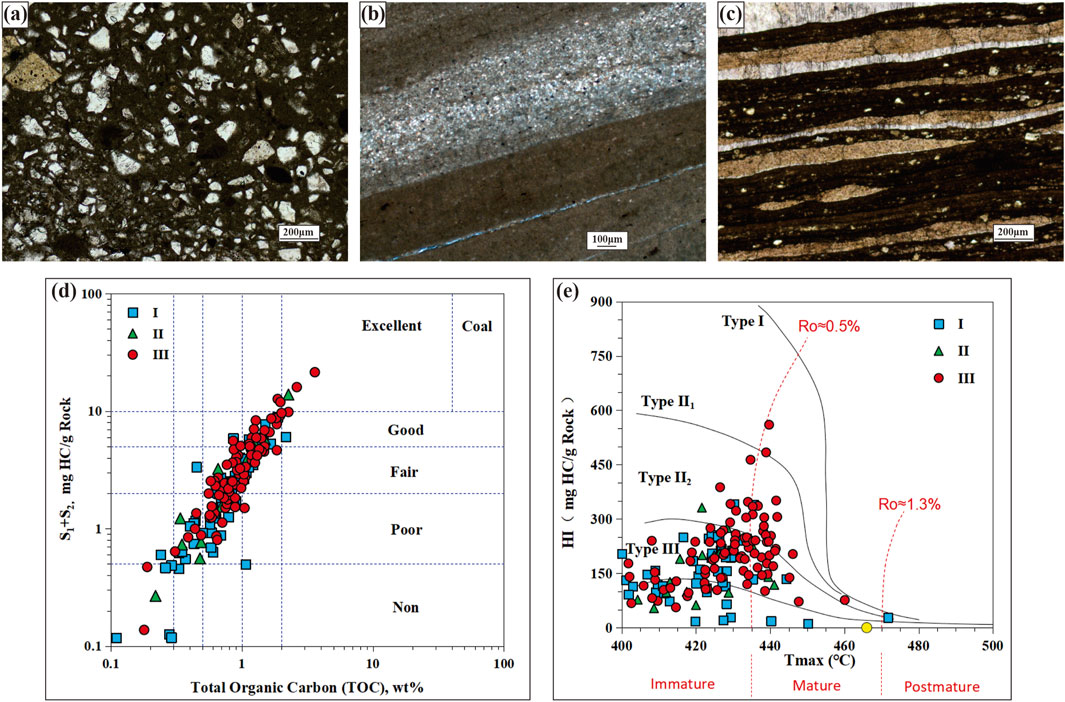
Figure 5. The difference of hydrocarbon generation among three lithofacies. (A) Lithofacies I; (B) Lithofacies II; (C) Lithofacies III; (D) Cross-plot of TOC content and S1+S2 content; (E) Cross-plot of Tmax and HI.
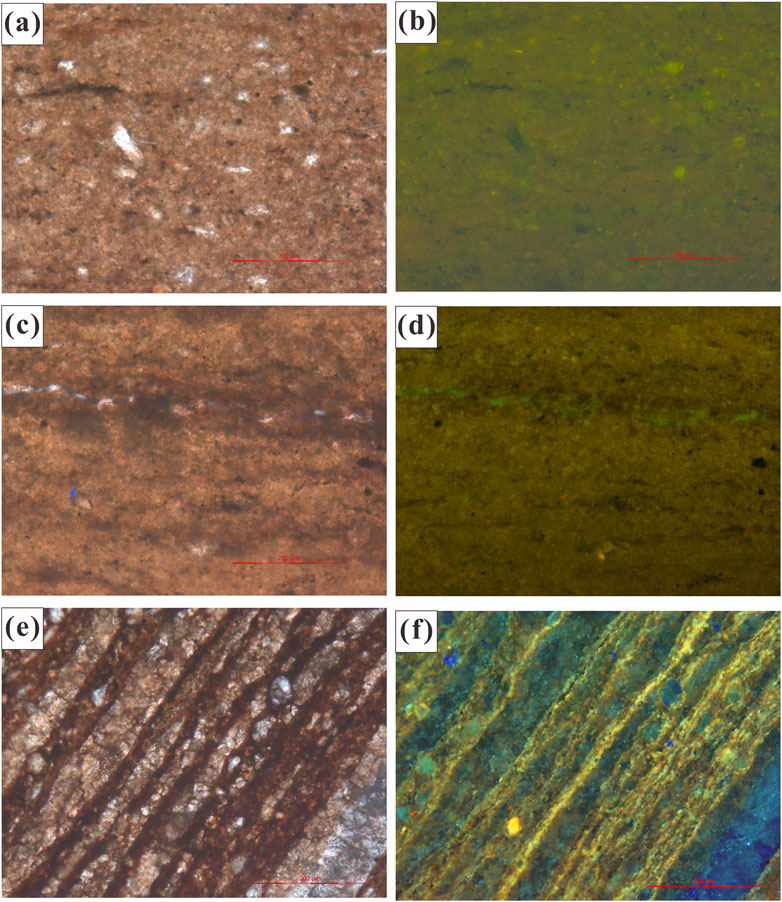
Figure 6. Microscope characteristics of different lithofacies. (A) Normal light, Wei 457HF, 3,667.17 m; (B) fluorescence, Wei 457HF, 3,667.17 m; (C) Normal light, Wei 457HF, 3,694.82 m; (D) fluorescence, Wei 457HF, 3,694.82 m; (E) Normal light, Wei 457HF, 3,697.59 m; (F) fluorescence, Wei 457HF, 3,697.59 m.
The TOC contents of Lithofacies II range from 0.09–2.17 w. t. %, with an average of 0.91 w. t. % (Figure 5B). Most samples in this facies have TOC values around 1 w. t. % (Figure 5D). The OM types are primarily Type III and Type II2 (Figure 5E), indicating a mixed contribution from terrigenous and aquatic sources. Laminar fractures are noted between the clay layers and clastic mineral layers, with oriented OM present within the clay layers. The OM appears relatively dispersed, displaying weak fluorescence intensity under microscopy (Figures 6C, D). Tmax ranges from 396°C–513°C, with an average of 427°C. The average Ro of Lithofacies II is 0.83, indicating that the Lithofacies I shale is in the mature stage.
The TOC contents of Lithofacies III (Figure 5C) range from 0.12–3.61 w. t. %, with an average of 1.02 w. t. %. The kerogen type is predominantly Type II1 and Type II2, indicating quatic OM (Figure 5E). The OM interacts with clay minerals through flocculation, resulting in the OM-clay layers formation. Under fluorescence microscopy, the clay-rich laminae demonstrate strong fluorescence, whereas the carbonate rock laminae show weak fluorescence or none at all (Figures 6E, F). Tmax ranges from 390°C–460°C, with an average of 436°C. The average Ro of Lithofacies II is 0.91, indicating that the Lithofacies I shale is in the mature stage. Results show that Lithofacies III has the highest TOC content and the best organic matter quality, suggesting a greater hydrocarbon generation potential.
The S1 content has been widely used as an indicator of oil content in shale (Hu et al., 2021a; Guan et al., 2022). Jarvie et al. (2017) introduced the oil saturation index (OSI = 100*S1/TOC) to characterize the mobility of shale oil, a metric that has been applied in various terrestrial shale formations in China (Jarvie et al., 2017; Wang et al., 2022a; Zhang et al., 2022). Therefore, this study employs the S1 value corrected for light hydrocarbons (S1C) and OSI to assess the oil content and mobility of different lithofacies. The results indicate that S1C contents for Lithofacies I range from 0.01 to 6.03 mg/g, with an average of 1.22 mg/g, while OSI values range from 1 to 424 mg/g TOC, with an average of 135 mg/g TOC. For Lithofacies II, S1C values range from 0.03 to 8.32 mg/g, averaging 1.80 mg/g, and OSI values range from 13 to 394 mg/g TOC, with an average of 181 mg/g TOC. Lithofacies III exhibits S1C values ranging from 0.01 to 6.08 mg/g, with an average of 1.94 mg/g, and OSI values from 11 to 713 mg/g TOC, averaging 188 mg/g TOC. Comparative results show that Lithofacies III has the highest oil content and best mobility.
Anomalies in geochemical data are key indicators of micro-migration phenomena (Liu et al., 2023; Hu et al., 2024b; Hu et al., 2025). The Productivity Index (PI) shows a negative correlation with Tmax (Figure 7A), suggesting that substantial amounts of hydrocarbons persist even at low Tmax values. Additionally, the S2/(S1+S2) ratio shows a positive correlation with Tmax, indicating that the proportion of S1 is higher at lower maturity levels (Figure 7B). Tmax negatively correlates with TOC (Figure 7C), suggesting that organic-rich shales have migrated towards areas with lower organic carbon content during hydrocarbon generation pressurization. This migration results in positive anomalies in the Oil Saturation Index (OSI) and PI, alongside a negative anomaly in Tmax. Notably, these anomalies intensify with decreasing TOC. As organic-rich shales reach the adsorption capacity, hydrocarbons begin migrating into adjacent low-organic shales with more favorable reservoir properties. Overall, these data suggest that micro-migration has occurred across different shale lithofacies, highlighting the dynamic nature of hydrocarbon migration within geological formations.

Figure 7. (A) Cross-plot of Tmax and PI; (B) Cross-plot of Tmax and S2/(S1+S2); (C) Cross-plot of TOC and Tmax. Red, blue, and green points represent the lithofacies I, lithofacies II, and lithofacies III, respectively.
Micro-migration hydrocarbon content across the three types of lithofacies was assessed using the δQ method, with results detailed in Table 1. For Lithofacies I, the original hydrocarbon index (HIo) ranged from 53 to 1,673 mg/g TOC, with an average of 249 mg/g TOC. The overall δQ values for this lithofacies ranged from −393–912 mg/g TOC, yielding an average of −123 mg/g TOC. Lithofacies II exhibited an HIo ranging from 18 to 1,565 mg/g TOC, with an average of 216 mg/g TOC. The overall δQ for Lithofacies II varied between −713 and 635 mg/g TOC, with an average of −106 mg/g TOC. Lithofacies III had an HIo range from 25 to 917 mg/g TOC, with an average of 216 mg/g TOC. The overall δQ for this lithofacies ranged from −493 to 347 mg/g TOC, averaging −138 mg/g TOC. Notably, the micro-migration in Lithofacies III was found to be more pronounced compared to the other lithofacies. In terms of OSI, Lithofacies III recorded the highest OSI at 188.09 mg/g TOC, followed closely by Lithofacies I with an OSI of 181.75 mg/g TOC. Lithofacies II had the lowest OSI, measuring 134.93 mg/g TOC. These findings indicate that Lithofacies III not only exhibited the most significant micro-migration but also had the highest S1 and OSI, suggesting a more favourable condition for hydrocarbon retention and migration.
The hydrocarbon generation potential and the composition of hydrocarbon-forming organisms are crucial factors influencing shale oil enrichment (Mackenzie et al., 1983; Begum et al., 2019; Hu et al., 2021b). A strong positive correlation between TOC and S1C (Figure 8A) indicates that higher organic matter abundance corresponds to increased oil content. However, when TOC exceeds 1 w. t. %, the adsorption capacity of organic matter increases, which restricts oil mobility (Yang et al., 2019; Awad et al., 2020; Xiao et al., 2024). The HIo provides a more accurate assessment of primary hydrocarbon generation potential than hydrogen index (HI) and can be used to determine whether variations in organic matter type affect shale oil content (Pepper, 1991; Wu, 2023). As shown in Figure 8B, higher HIo correlates with higher oil content, suggesting that shale with higher organic matter types contributes more to shale oil resources (Quan et al., 2022). Figure 8C shows that S1C increases and then decreases with rising Tmax. In the mature stage of shale, kerogen cracking generates significant hydrocarbons; However, excessive maturity leads to the hydrocarbon degradation, reducing oil content (Shao et al., 2020). Therefore, hydrocarbon generation potential is a controlling factor for shale oil content. The correlation between OSI and TOC, HIo, and Tmax is relatively weak (Figures 8D–F), indicating that hydrocarbon generation capacity may not significantly influence shale oil mobility.
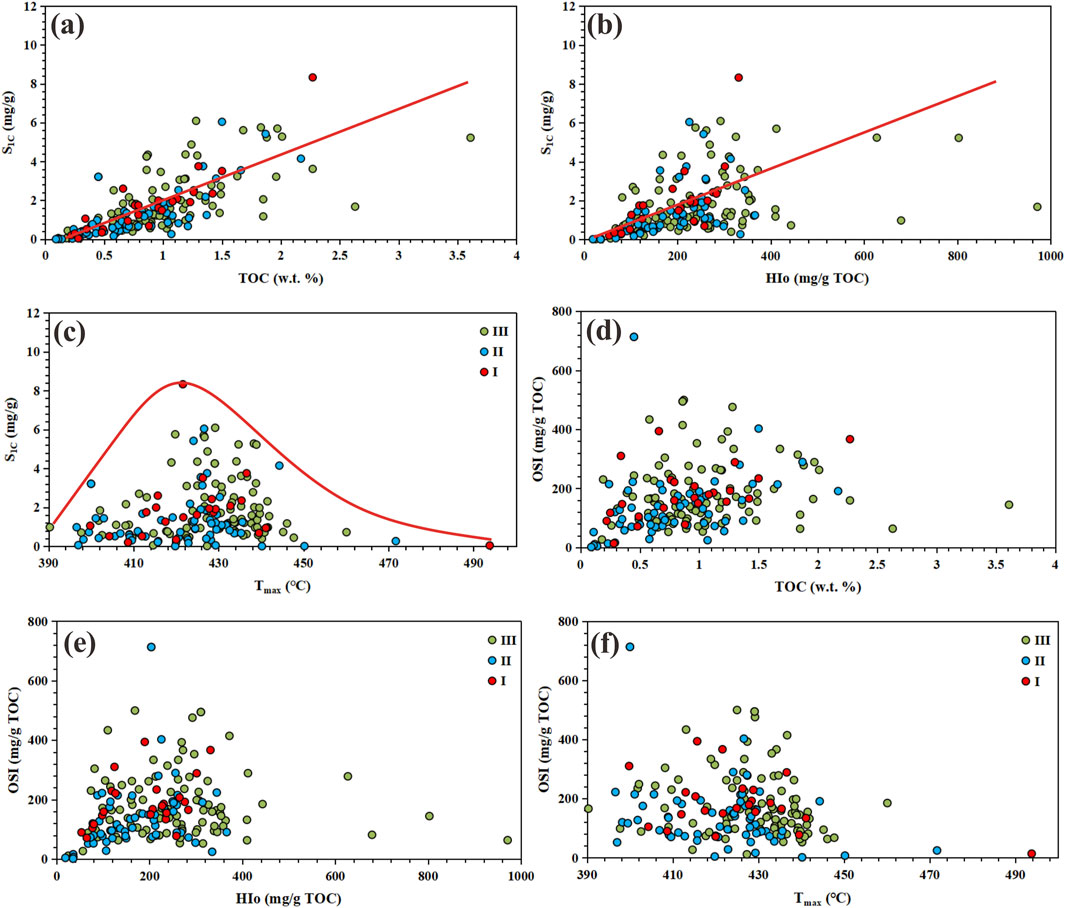
Figure 8. The relationship between hydrocarbon generation capacity, oil content, and mobility. (A) TOC vs. S1C; (B) HIo vs. S1C; (C) Tmax vs. S1C; (D) TOC vs. OSI; (E) HIo vs. OSI; (F) Tmax vs. OSI.
Lithofacies III stands out for containing more samples with high TOC and oil content compared to other lithofacies. We analyzed the differences in oil content among the three lithofacies from the perspectives of sedimentary environment and hydrocarbon-forming organisms. Lithofacies I primarily contains organic matter (OM) dominated by vitrinite, with present in smaller quantities (Figure 9A). In Lithofacies II, sedimentary conditions transitioned to deeper waters, increasing the phytoplankton content while decreasing vitrinite (Figures 9C, D), reflecting a reduction in terrestrial input. Lithofacies III, indicative of deep to semi-deep lacustrine deposition, exhibits the highest phytoplankton content. Fluorescence microscopy observations have identified bundant cyanobacterial laminations in this lithofacies (Figures 9E–H). The type and quantity of organic matter during sedimentation were significantly influenced by the sedimentary environment and mineralogical factors. High productivity coupled with reducing environments promoted the organic matter enrichment. Moreover, the origin, abundance, and preservation of organic matter played a crucial role in determining hydrocarbon source rock potential (Young and McIver, 1977). Research indicates that algae and plankton exhibit higher oil generation potential than higher plant-derived organic matter, which generally has a lower oil generation capacity (Bouchez et al., 2011; Lupker et al., 2011; Garzanti et al., 2010). Consequently, the interaction between sedimentary environments and the types of hydrocarbon-forming organisms explains the differences in shale oil content across the lithofacies.
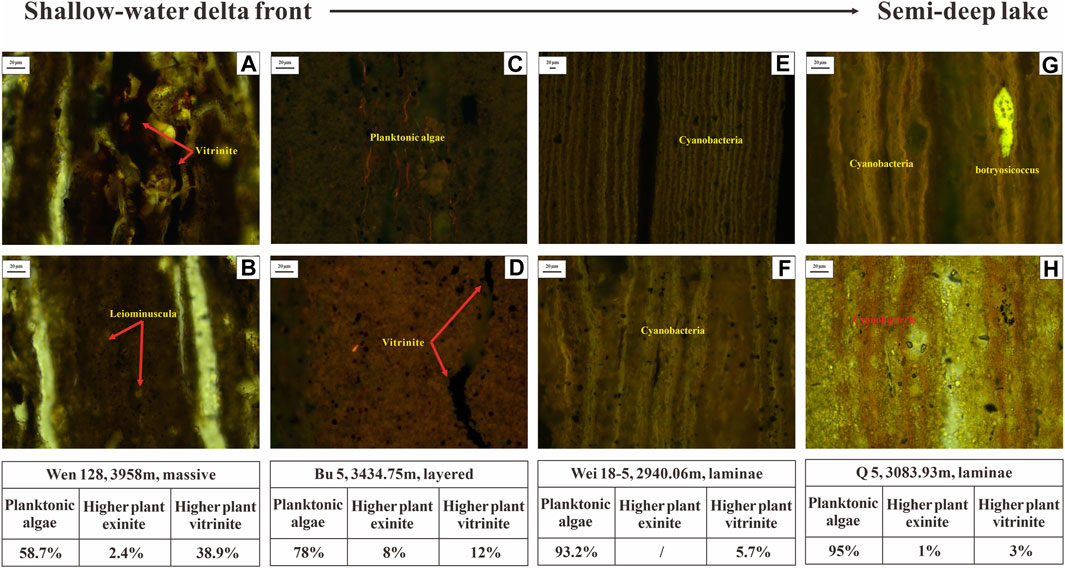
Figure 9. Characteristics of hydrocarbon-forming organisms of different lithofacies. (A, B), The proportion of Planktonic algae is 58.7% in massive shales; (C, D), The proportion of Planktonic algae is 78% in layered shales; (E–H), The percentage of Planktonic algae is over 90%.
Table 1 shows that Lithofacies III possesses the highest oil content and mobility. We conducted an analysis of the shale oil occurrence characteristics in Lithofacies III. Intergranular pores and calcite dissolution pores associated with felsic minerals exhibit good connectivity and can store significant amounts of free oil (Figures 10A, E, I) (Loucks et al., 2009; Mastalerz et al., 2013; Wang et al., 2019). Conversely, shale oil is less likely to accumulate in pyrite aggregates, where the pore structure is less conducive to hydrocarbon storage (Figures 10C, D, J). Clay minerals, while contributing to stronger adsorption capacity and confinement effects, can hinder the mobility and flowability of hydrocarbons, resulting in poorer oil recovery (Allawe et al., 2015; Mastalerz et al., 2018; Xu et al., 2021). However, when the pore space within clay minerals is sufficiently large and well-connected, it can still facilitate the deposition of free oil (Figure 10B). Adsorbed oil primarily resides in the pores of organic matter, with oil enrichment being more likely in organic matter pores that have larger pore sizes and good connectivity (Figures 10F–H). The width of fractures is another critical factor influencing shale oil occurrence (Aydin, 2000). Wider fractures are associated with a greater presence of free oil, while narrower fractures tend to retain more adsorbed oil (Figure 10C). Notably, Lithofacies III exhibits wider fractures, which enhances the potential for oil mobility. The connection between vertical and bedding fractures creates pathways that facilitate micro-migration of shale oil, resulting in increased mobility and hydrocarbon recovery potential. This interplay of pore structure, mineral composition, and fracture characteristics underscores the complexity of shale oil enrichment and the factors that influence its distribution and mobility.
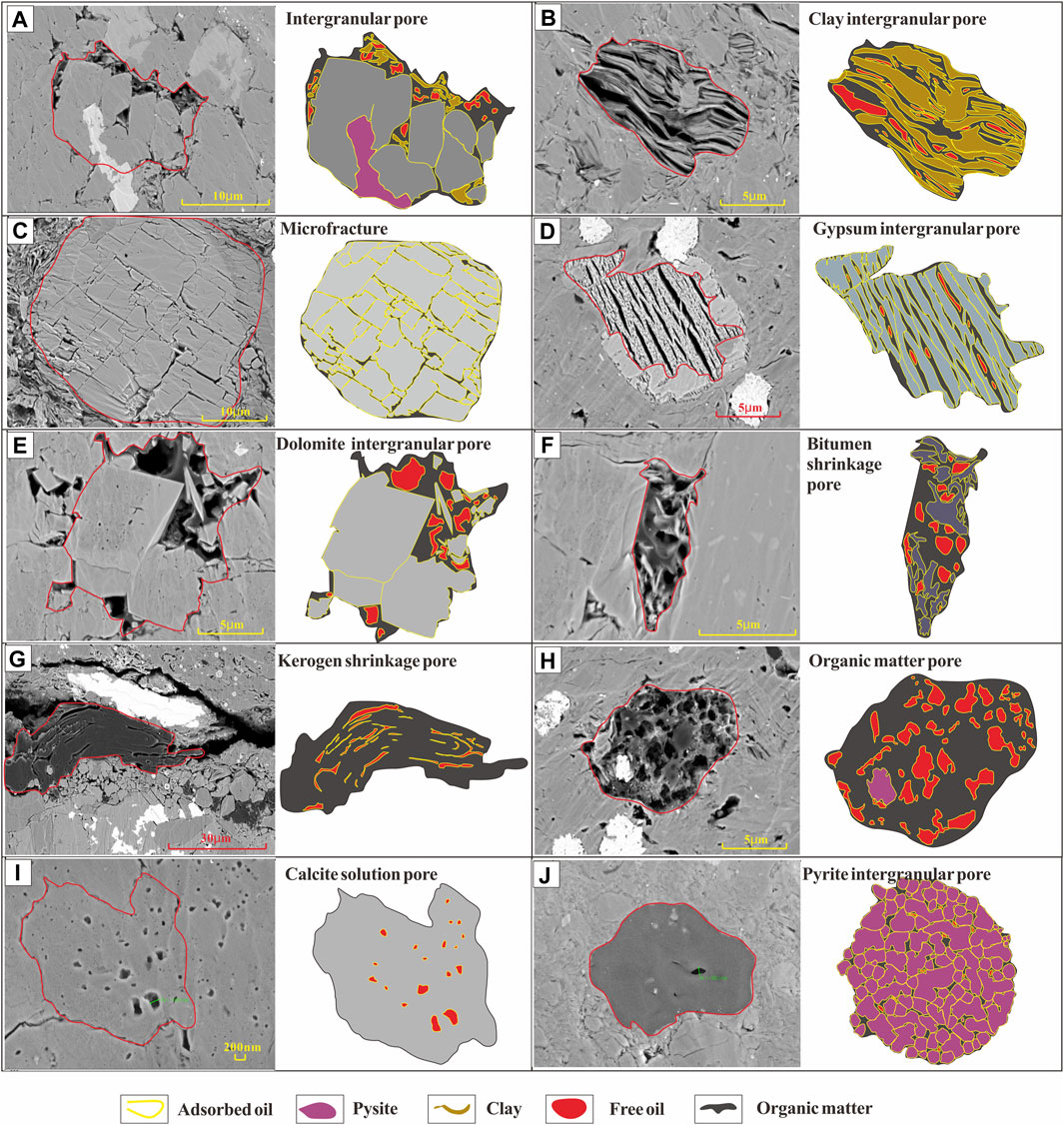
Figure 10. Shale oil occurrence characteristics of hybrid sedimentary shales in the Dongpu Depression. (A) Intergranular pore of feldspar; (B) Clay intergranular pore; (C) Microfractures formed by gypsum minerals; (D) Gypsum intergranular pore; (E) Dolomite intergranular pore; (F) Bitumen shrinkage pore; (G) Kerogen shrinkage pore; (H) Organic matter pore; (I) Calcite solution pore; (J) Pyrite intergranular pore.
Pore structures play a crucial role in determining the enrichment space for oil and gas, and these structures are primarily influenced by mineral composition (Loucks et al., 2009; Liu et al., 2021; Wang et al., 2022b). The mineral composition of shale not only affects pore evolution but also influences adsorption capacity, which is essential for determining the characteristics of shale oil. In this study, we analyzed the impact of different minerals on the oil content and mobility of HSS oil.
The results indicate that as the clay mineral content increases, S1C initially increases and then decreases (Figure 11A). The strong adsorption capacity of clay minerals for organic matter enhances the hydrocarbon generation potential of shale, leading to higher oil content (Sandvik et al., 1992; Ahmat et al., 2017; Zhao et al., 2022a). However, excessively high clay mineral content can occupy pore space, limiting the shale’s ability to contain additional oil (Du et al., 2024). Similarly, feldspar minerals exhibit a corresponding trend with S1C, likely due to their high brittleness (Figure 11B). A certain content of feldspar improves pore space and connectivity, which is conducive to the storage of shale oil, while excessive felsic contents promote the hydrocarbon expulsion, which is not conducive to the shale oil accumulation. The correlation between carbonate minerals and S1C is relatively weak (Figure 11C), suggesting that carbonate minerals have a limited effect on the oil content of shale. The positive correlation between clay mineral content and OSI can be attributed to two main reasons (Figure 11D). First, clay minerals have small particle sizes and large specific surface areas, leading to rapid adsorption kinetics and strong adsorption stability for organic matter. Consequently, the generated hydrocarbons are easily adsorbed by clay minerals and are less likely to be released. Second, the pores in clay minerals are primarily composed of nanopores, which impose stronger confinement effects on shale oil, significantly reducing the micro-migration of hydrocarbons (Lanson et al., 1998; Peltonen et al., 2009). As the content of feldspar minerals increases, OSI shows a trend of initially increasing and then decreasing (Figure 11E). This phenomenon may be due to the improved pore connectivity that facilitates the expulsion of shale oil from the reservoir, thereby reducing S1C and resulting in a lower OSI. In contrast, carbonate minerals exhibit a positive correlation with OSI (Figure 11F), indicating that higher carbonate mineral content enhances mobility. The layered fractures and hydrocarbon pressurized fractures within carbonates serve as pathways for micro-migration, facilitating the movement of generated hydrocarbons into carbonate reservoirs (Aydin, 2000; Gale et al., 2004; Liu et al., 2020).
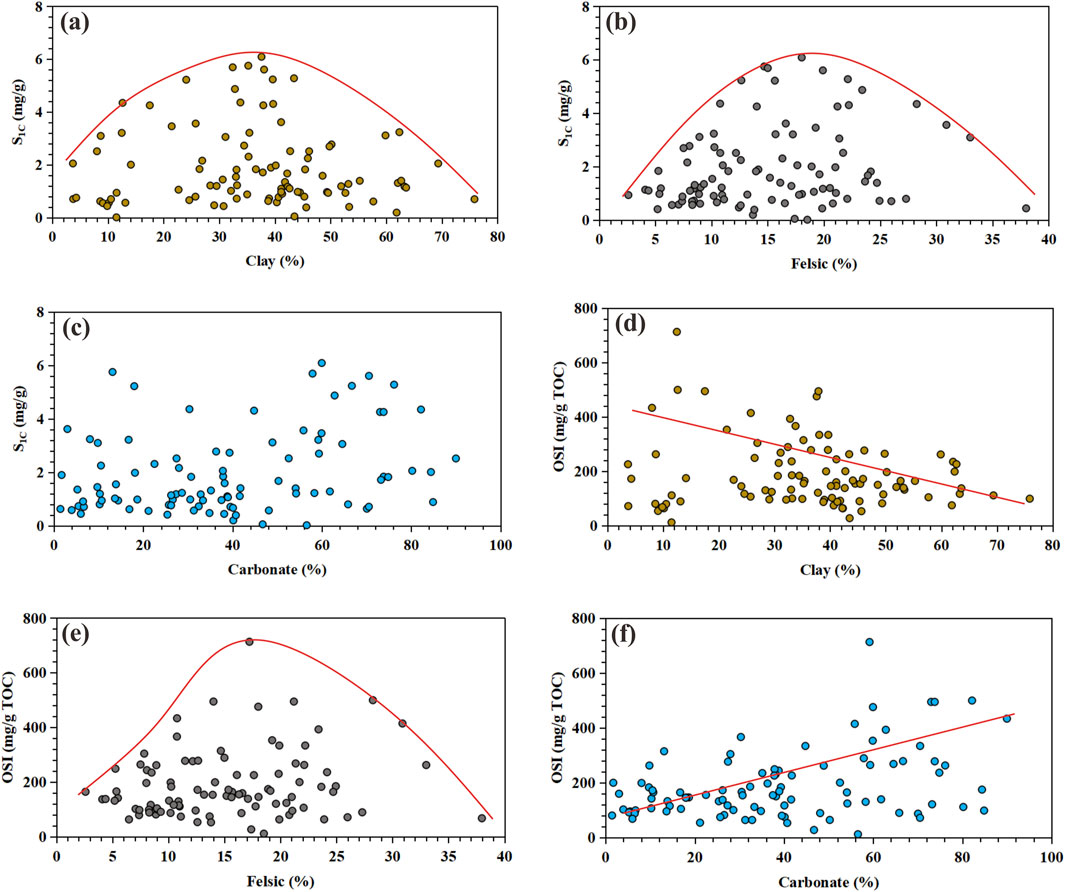
Figure 11. The relationship between inorganic minerals and oil content and mobility. (A) Clay minerals vs. S1C; (B) Felsic minerals vs. S1C; (C) Carbonate minerals vs. S1C; (D) Clay minerals vs. OSI; (E) Felsic minerals vs. OSI; (F) Carbonate minerals vs. OSI.
Preservation conditions play a significant role in determining the content and composition of shale oil (Zhao et al., 2023b; Usman et al., 2024). Organic-rich shales are important as they function both as traditional source rocks and as reservoirs for shale oil and gas (Bou Daher et al., 2014; Bou Daher et al., 2015). Results indicate differences in pore development among the various lithofacies. Lithofacies I exhibits the micropores and mesopores, while Lithofacies II and III are characterized by the predominance of mesopores and macropores (Figures 12A–C). In the case of the Shahejie Formation, the porosity is relatively low, averaging less than 5% (specifically, 2.6%), and the permeability is quite limited, measuring less than 0.1 × 10−3 μm2 (with an average of 0.037 × 10−3 μm2). These poor physical properties pose challenges for the migration and enrichment of shale oil and gas. However, development of salt minerals such as halite, gypsum, and carbonate minerals in the DD create favourable conditions for the storage and migration of shale oil (Poetz et al., 2014; Wu et al., 2023). The presence of these minerals contributes to the formation of micro-migration pathways that enhance the movement of hydrocarbons (Lanson et al., 1998; Milliken et al., 2012; Eyong et al., 2018). Using the Monte Carlo method, researchers calculated that the porosity of intersalt overpressure fractures in the Shahejie Formation ranges from 0.02% to 0.99%, with an average of 0.58%. This indicates that these fractures contribute approximately 22.3% to the total porosity of the shale. Additionally, the permeability of these intersalt overpressure fractures ranges from 0.001 to 0.860 × 10−3 μm2, averaging 0.019 × 10−3 μm2, which accounts for about 51.4% of the shale’s overall permeability. The findings highlight that intersalt overpressure fractures significantly enhance the porosity of shale reservoirs while also serving as the primary conduits for the seepage of shale oil and gas (Gale et al., 2004; Zanella et al., 2014; Liu et al., 2020). This dual role is crucial for understanding the dynamics of hydrocarbon migration and enrichment within these complex geological formations.
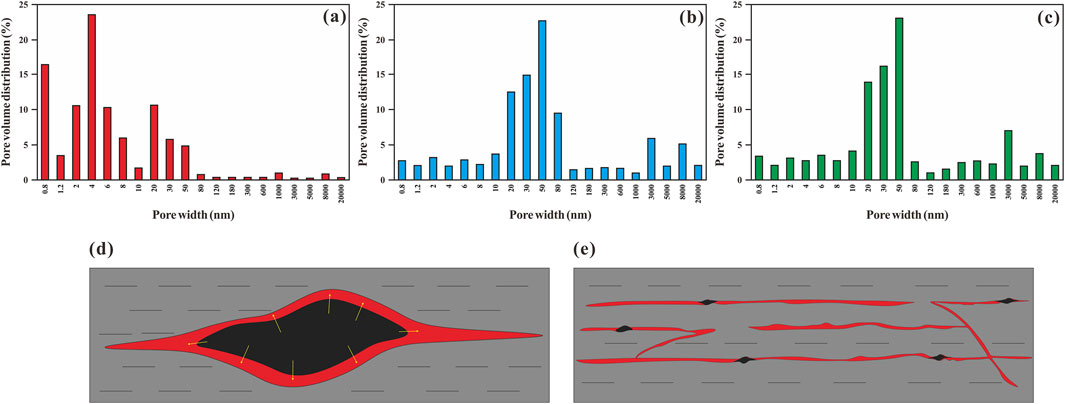
Figure 12. Pore width distribution for different lithofacies and hydrocarbon generation pressure model: (A) Lithofacies I, Well Wen 318, 3,874.41 m; (B) Lithofacies II, Well Wen 138, 3,932.53 m; (C) Lithofacies III, Well Wen 318, 3,918.92 m; (D, E) hydrocarbon generation pressure model.
The pressure generated during kerogenic hydrocarbon generation is a key driving force behind hydrocarbon migration, with fractures induced by this pressure serving as essential pathways for micro-seepage (Figure 12D) (Tyson, 2001; Wu et al., 2018; Jia et al., 2021; Sharifi et al., 2021). As hydrocarbons generate, the resulting pressure creates overpressure fractures that extend horizontally through the strata and interconnect at their endpoints (Zanella et al., 2014; Wu et al., 2016). Under the influence of fluid pressure, newly formed shale oil migrates along the path of least resistance within the shale matrix (Figure 12E). This process facilitates the gradual enrichment of oil into larger structural and diagenetic fractures, enabling short-distance migration of shale oil and gas (Chapman, 1972; Wu et al., 2021). Following this primary migration, a substantial quantity of organic matter, along with residual oil and gas, remains trapped within the intricate fracture network (Ko et al., 2016; Ko et al., 2018). This network ultimately evolves into an interconnected organic matter framework, leading to the development of an organic-rich zone characterized by high porosity, which acts as the primary reservoir space for shale oil and gas. Consequently, the interconnected fracture network within over-pressured shales plays a dual role: it is both the principal pathway for the initial migration of hydrocarbons and a crucial reservoir space within shale formations. This network significantly influences the aggregation and enrichment of shale oil and gas, highlighting its importance in the overall dynamics of hydrocarbon enrichment within these geological systems.
The results showed that δQ has a significant negative correlation with S1C and OSI (Figure 13), indicating that shales with obvious micro-migration have higher mobility and hydrocarbon expulsion potential. In addition, the micro-migration phenomenon is most pronounced in Lithofacies III, which corresponds to higher oil content and mobility (Figure 13). Shale oil enrichment is controlled by hydrocarbon generation capacity, reservoir capacity, and preservation conditions (Lu et al., 2012; Curtis and Zumberge, 2018). Micro-migration is the bridge connecting these factors (Hu et al., 2024a). Shale with strong hydrocarbon generation potential can lead to poor oil content due to hydrocarbon expulsion, while shale with weak hydrocarbon generation potential can have good oil content due to hydrocarbon charging (Bernard et al., 2012b; Hu et al., 2024b). The proportion of heavy components in shale where hydrocarbon expulsion occurs is high, while the proportion of light components in shale that receives hydrocarbons is high (Leythaeuser et al., 1988).
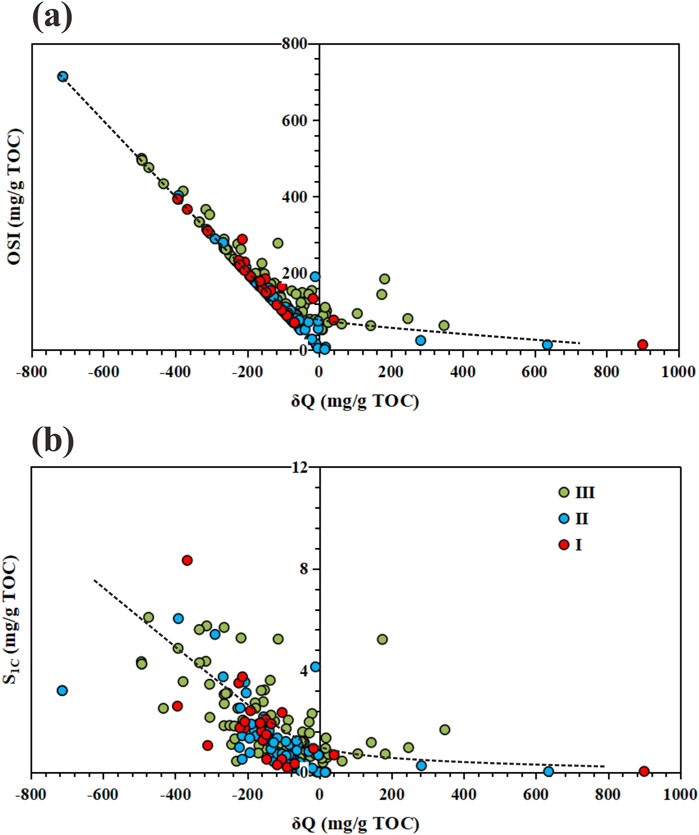
Figure 13. The relationship between micro-migration and oil content and mobility. (A) δQ vs OSI; (B) δQ vs S1C.
Petroleum micro-migration encompasses the entire process of oil generation, expulsion, and subsequent enrichment (Chapman, 1972; Todaro et al., 2022). The migration of hydrocarbons is influenced by a variety of factors, including geological, chemical, and physical conditions (Katz and Lin, 2014). Micro-migration plays a critical role in the enrichment of shale oil, as evidenced by variations in oil content and composition (Hu et al., 2024a; Hu et al., 2024b; Wu et al., 2024a). Identifying and evaluating the pathways and mechanisms of shale oil micro-migration can provide essential theoretical support for establishing differential shale oil enrichment models. Understanding these dynamics can help pinpoint areas with varying enrichment levels and hydrocarbon potential (Ross and Bustin, 2008a; Ross and Bustin, 2008b; Curtis and Zumberge, 2018). Furthermore, the intervals of micro-migration should also be assessed in terms of shale oil content and the identification of “movable sweet spots,” where the shale oil is more easily extractable. This approach allows for a more nuanced understanding of shale reservoirs and can guide exploration and production strategies, maximizing the efficiency and effectiveness of hydrocarbon recovery efforts.
The controlling factors of shale oil content and mobility were determined by Pearson correlation analysis in this study (Figure 14). A positive coefficient indicates a positive correlation between the two parameters, and a negative coefficient indicates a negative correlation between the two parameters. The closer the coefficient is to ±1, the stronger the correlation between the two parameters. The results indicated that TOC (correlation coefficient with S1C: 0.70), Tmax (correlation coefficient with S1C: 0.56), and δQ (correlation coefficient with S1C: −0.54) are influential factors affecting the HSS oil content. Meanwhile, δQ (correlation coefficient with OSI: −0.81), clay minerals (correlation coefficient with OSI: 0.27), and carbonate minerals (correlation coefficient with OSI: 0.46) are the factors influencing oil mobility. Among these, TOC has the highest correlation coefficient with S1C, while δQ has the highest correlation coefficient with OSI (Figure 14). Therefore, the key controlling factor for the oil content of HSS is TOC, while δQ serves as the main controlling factor for oil mobility.
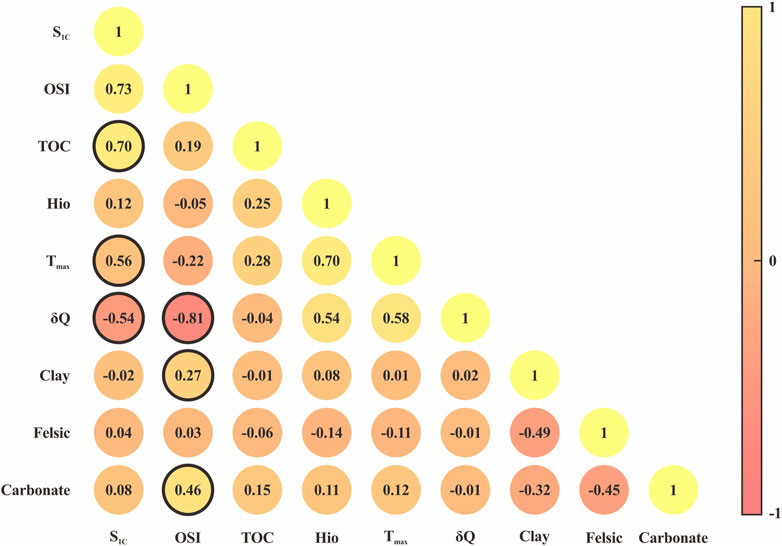
Figure 14. Pearson correlation analysis heat map for main controlling factors of hybrid sedimentary shale oil content and mobility.
We compared the oil content and mobility of the DD with the Delaware and Midland Basins in the United States and the Mahu Sag in China to reveal the connections and differences in HSS oil across these regions.
In the Wolfcamp A Formation of the Delaware and Midland Basins, the high-quality source rock primarily consists of basal carbonate facies, overlaid by calcareous or siliceous mudrocks (Gaswirth et al., 2016; Zhang et al., 2021). The average TOC content is 2.88 wt%, with an average S1 content of 3.68 mg/g and an average OSI of 128 mg/g TOC (Table 2). Siliceous mudrocks exhibit higher TOC content (average: 3 w. t.%), while thin carbonate laminae show the lowest TOC content (average: 1 w. t.%). A stable tectonic environment promotes the enrichment and preservation of organic matter, resulting in high-quality organic-rich source rocks (Breyer, 2012; Ko et al., 2018; Li et al., 2019). Meter-scale laminae cycles likely contributes to oil production from the Wolfcamp A. Micro-migration allows oil generated from organic matter-rich mudrocks to be charged into organic matter-poor carbonate laminae through vertical microfractures, leading to shale oil accumulation (Sandvik et al., 1992; Eseme et al., 2012). Additionally, the micro-migration of organic-rich siliceous mudstone and calcareous mudstone resulted in high oil saturation of the Wolf Camp A (Barker, 1990; Jarvie et al., 2017).
The Fengcheng Formation in the Mahu Sag has a relatively low TOC content (average: 0.92 wt%), but higher S1 content (average: 3.52 mg/g) and OSI values (average: 382 mg/g TOC) (Zhang et al., 2022). The unique alkaline minerals present in the Fengcheng Formation facilitate early hydrocarbon generation and an extended oil window, resulting in a sustained supply of oil and gas (Zhi et al., 2016; Jiang et al., 2023b). The shale in the Fengcheng Formation possesses more pore space and better connectivity, contributing to high oil mobility and considerable commercial development potential (Li et al., 2023). Hu et al. (2024a), Hu et al. (2024b) found that micro-migration in the Fengcheng shale is prominent, with both lateral and vertical micro-migration enhancing the shale oil accumulation.
TOC contents of the Shahejie Formation HSS in the DD averages 1.02 wt%, which is intermediate between the Fengcheng Formation and the Wolfcamp A Formation. Although the oil content is relatively low (average S1: 1.94 mg/g), its mobility (average OSI: 188 mg/g TOC) is higher than the Wolfcamp A Formation. The DD is characterized by typical saline lake sedimentation, where salt minerals enhances organic matter hydrocarbon generation. However, frequent tectonic activities and a complex sadimentary environment increase the heterogeneity of the HSS (Wu et al., 2024b), leading to more complex micro-migration of oil and gas. Consequently, the distribution of shale oil resources in the DD exhibits a more fragmented characteristic.
Comparison results indicate that the HSS oil enrichment in three basins is controlled by micro-migration. Differences in oil content and mobility are primarily related to sedimentary environment and tectonic background. A stable sedimentary environment is conducive to the development of source rocks, providing the basis for shale oil formation. Good reservoir capacity and micro-migration pathways are key factors for HSS oil enrichment. Future research should focus on comparing the sedimentary environments, tectonic evolution, and organic matter characteristics of different basins to identify the key factors controlling the reservoir capacity of HSS oil. Our study provides a theoretical foundation for the exploration and development of global HSS, promoting the sustainable utilization of regional oil and gas resources.
Three lithofacies types of HSS have been identified in the lacustrine basin: massive argillaceous shale (lithofacies I), bedded argillaceous shale (lithofacies II), and laminated calcareous shale (lithofacies III). Lithofacies III features the highest average TOC (1.56 w. t. %), hydrogen index (HI) (264 mg/g TOC), oil content S1C (1.81 mg/g), and oil mobility OSI (188 mg/g TOC). Micro-migration phenomena were identified based on anomalies in the geochemical data, and the quantity of hydrocarbons involved in micro-migration (δQ) was assessed. Results show that Lithofacies III exhibits the most pronounced micro-migration with an average δQ of −138 mg/g TOC.
Correlation analysis shows that TOC (correlation coefficient: 0.70), Tmax (correlation coefficient: 0.56), and δQ (correlation coefficient: -0.54) influence the oil content of HSS. TOC emerges as the primary controlling factor, suggesting that shales with high organic matter abundance possess better hydrocarbon generation potential and can produce more shale oil. Conversely, δQ (correlation coefficient: -0.81), clay minerals (correlation coefficient: 0.27), and carbonate minerals (correlation coefficient: 0.46) affect mobility. δQ is the main controlling factor for mobility, indicating that micro-migration governs the connectivity, transport, and enrichment of shale oil within the drainage and receiving units.
Through comparisons across different basins, we find that the HSS oil enrichment is influenced by micro-migration, while variations in oil content and mobility are primarily associated with sedimentary environment and tectonic background. Future research should focus on detailed analyses of the relationships among sedimentary environments, tectonic evolution, and organic matter to identify key factors affecting HSS oil enrichment. Our study provides insights into the controlling factors of HSS oil enrichment and offers new perspectives for global HSS oil exploration and development.
The raw data supporting the conclusions of this article will be made available by the authors, without undue reservation.
JD: Writing–original draft, Writing–review and editing. YX: Writing–original draft, Writing–review and editing. BY: Writing–review and editing. LL: Writing–review and editing. TX: Writing–review and editing. DW: Writing–review and editing. KC: Writing–review and editing. DY: Writing–review and editing. HL: Writing–review and editing.
The author(s) declare financial support was received for the research, authorship, and/or publication of this article. This research was funded by the Zhongyuan Oilfield Science and Technology Research Project (QDLY2306), Zhongyuan Oilfield Cooperation Project (31300027-23-ZC0613-0013), and SINOPEC.
The authors thank the Zhongyuan Oilfield Branch, SINOPEC for its support of this research.
Authors JD, YX, BY, LL, TX, DW, KC, DY, and HL were employed by SINOPEC.
The authors declare that this study received funding from SINOPEC. The funder had the following involvement in the study: study design, analysis, and interpretation of data.
The author(s) declare that no Generative AI was used in the creation of this manuscript.
All claims expressed in this article are solely those of the authors and do not necessarily represent those of their affiliated organizations, or those of the publisher, the editors and the reviewers. Any product that may be evaluated in this article, or claim that may be made by its manufacturer, is not guaranteed or endorsed by the publisher.
Ahmat, A. M., Boussafir, M., Le Milbeau, C., Guégan, R., De Oliveira, T., and Le Forestier, L. (2017). Organic matter and clay interaction in a meromictic lake: implications for source rock OM preservation (Lac Pavin, Puy de-Dôme, France). Org. Geochem. 109, 47–57. doi:10.1016/j.orggeochem.2017.03.014
Allawe, E. M., Stockdale, A. P., Aminiaa, K., and Ameri, S. (2015). Impact of nanoscale pore confinement on estimation of gas resources and gas/condensate behavior in shale reservoirs. SPE East. Reg. Meet. Morgant. W. Va. U. S. A., 2015. doi:10.2118/177285-MS
Altawati, F., Emadi, H., and Pathak, S. (2021). Improving oil recovery of eagle ford shale samples using cryogenic and cyclic gas injection methods: an experimental study. Fuel 302, 121170. doi:10.1016/J.FUEL.2021.121170
Awad, A. M., Jalab, R., Benamor, A., Nasser, M. S., Ba-Abbad, M. M., El-Naas, M., et al. (2020). Adsorption of organic pollutants by nanomaterial-based adsorbents: an overview. J. Mol. Liq. 301, 112335. doi:10.1016/j.molliq.2019.112335
Aydin, A. (2000). Fractures, faults, and hydrocarbon entrapment, migration and flow. Mar. Pet. Geol. 17 (7), 797–814. doi:10.1016/S0264-8172(00)00020-9
Barker, C. (1990). Calculated volume and pressure changes during the thermal cracking of oil to gas in reservoirs. AAPG Bull. 74 (8), 1254–1261. doi:10.1306/0C9B247F-1710-11D7-8645000102C1865D
Begum, M., Yassin, M. R., and Dehghanpour, H. (2019). Effect of kerogen maturity on organic shale wettability: a Duvernay case study. Mar. Pet. Geol. 110, 483–496. doi:10.1016/j.marpetgeo.2019.07.012
Bernard, S., Horsfield, B., Schulz, H. M., Wirth, R., Schreiber, A., and Sherwood, N. (2012a). Geochemical evolution of organic-rich shales with increasing maturity: a STXM and TEM study of the Posidonia Shale (Lower Toarcian, northern Germany). Mar. Pet. Geol. 31 (1), 70–89. doi:10.1016/j.marpetgeo.2011.05.010
Bernard, S., Wirth, R., Schreiber, A., Schulz, H. M., and Horsfield, B. (2012b). Formation of nanoporous pyrobitumen residues during maturation of the barnett shale (fort worth basin). Int. J. Coal Geol. 103, 3–11. doi:10.1016/j.coal.2012.04.010
Bouchez, J., Gaillardet, J., France-Lanord, C., Maurice, L., and Dutra-Maia, P. (2011). Grain size control of river suspended sediment geochemistry: clues from Amazon River depth profiles. Geochem. Geophys. Geosyst. 12 (3). doi:10.1029/2010GC003380
Bou Daher, S., Nader, F. H., Müller, C., and Littke, R. (2015). Geochemical and petrographic characterization of Campanian-lower Maastrichtian calcareous petroleum source rocks of Hasbayya, South Lebanon. Mar. Pet. Geol. 64, 304–323. doi:10.1016/j.marpetgeo.2015.03.009
Bou Daher, S., Nader, F. H., Strauss, H., and Littke, R. (2014). Depositional environment and source-rock characterisation of organic-matter rich upper santonian - upper campanian carbonates, Northern Lebanon. J. Pet. Geol. 37, 5–24. doi:10.1111/jpg.12566
Breyer, J. A. (2012). Shale reservoirs—giant resources for the 21st century. AAPG Mem. 97, 89–119. doi:10.1306/M971332
Chapman, R. E. (1972). Primary migration of petroleum from clay source rocks. AAPG Bull. 56, 2185–2191. doi:10.1306/819A41F8-16C5-11D7-8645000102C1865D
Curtis, J. B., and Zumberge, J. E. (2018). “Permian basin petroleum systems–Geochemical insight into hydrocarbon generation, migration and well performance,” in Society of exploration geophysicists unconventional resources Technology conference. July 23–25. doi:10.15530/urtec-2018-2901680
Du, J. Z., Cai, J. G., Zeng, X., Zhang, Y. X., Mu, X. S., and Wang, X. Y. (2024). Depositional and diagenetic controls on hydrocarbon generation of mudstones through clay–organic matter interactions: a comparative study of the Dongpu Depression, Bohai Bay Basin, China. J. Asian Earth Sci. 262, 106000. doi:10.1016/J.JSEAES.2023.106000
Edgell, H. S. (1996). Salt tectonism in the Persian Gulf basin. Geol. Soc. Lond. Spec. Publ. 100 (1), 129–151. doi:10.1144/gsl.sp.1996.100.01.10
Emmanuel, I. K., Ericmoore, J., and Kwesi, E. A. (2022). Characterization and mechanical property measurements by instrumented indentation testing of Niger delta oil shale cuttings. Int. J. Eng. Res. Afr., 648289–649100. doi:10.4028/P-2M9Z7G
Eseme, E., Krooss, B. M., and Littke, R. (2012). Evolution of petrophysical properties of oil shales during high-temperature compaction tests: implications for petroleum expulsion. Mar. Pet. Geol. 31 (1), 110–124. doi:10.1016/j.marpetgeo.2011.11.005
Eyong, J. T., Gabriel, N., Moïse, B., Hell, V. J., Eric, B. E., Wignall, P., et al. (2018). Sedimentologic and palaeoenvironmental evolution of the Mamfe Cretaceous Basin (SW Cameroon): evidence from lithofacies analysis, tectonics and evaporite minerals suite. J. Afr. Earth Sci. 149, 19–41. doi:10.1016/j.jafrearsci.2018.07.022
Gale, J. F. W., Laubach, S. E., Marrett, R. A., Olson, J. E., Holder, J., and Reed, R. M. (2004). Predicting and characterizing fractures in dolostone reservoirs: using the link between diagenesis and fracturing. Geol. Soc. Lond. Spec. Publ. 235 (1), 177–192. doi:10.1144/GSL.SP.2004.235.01.08
Gao, H. C., Chen, F. L., and Liu, G. R. (2009). Advance, problems and prospect of origin of salt rocks of paleogene Shahejie Formation in Dongpu sag. J. Palaeogeogr. 11 (03), 251–264. doi:10.7605/gdlxb.2009.03.001
Gao, L. J., Wu, P., Shi, X. F., Li, Y., Pang, J. D., and Yang, T. M. (2022). Logging interpretation and classification method of reservoir parameters ofmarine continental transitional shale based on source and reservoir type. Nat. Gas. Geosci. 33 (07), 1132–1143. doi:10.11764/j.issn.1672-1926.2022.01.007
Garzanti, E., Andó, S., France-Lanord, C., Censi, P., Vignola, P., Galy, V., et al. (2010). Mineralogical and chemical variability of fluvial sediments 2. Suspended-load silt (Ganga–Brahmaputra, Bangladesh). Earth Planet. Sci. Lett. 302, 107–120. doi:10.1016/j.epsl.2010.11.043
Gaswirth, S. B., Marra, K. R., Lillis, P. G., Mercier, T. J., Leathers-Miller, H. M., Schenk, C. J., et al. (2016). Assessment of undiscovered continuous oil resources in the Wolfcamp shale of the Midland basin, Permian Basin province, Texas. Reston, Virginia: US Geological Survey Fact, 2016–3092. doi:10.3133/fs20163092
Gharib, A. F., Ismael, J. I., Alatroshe, R. K., Farhan, H. N., Abdel-Fattah, H. I., and Pigott, J. D. (2024). Editorial expression of concern: organic matter characteristics and hydrocarbon generation potential of the middle jurassic–lower cretaceous succession in the mesopotamian foredeep basin, Iraq. Int. J. Earth Sci. 113, 219–2187. doi:10.1007/s00531-024-02485-9
Glikson-Simpson, M. (2021). Oil shales: a complete story. Cham: Springer. doi:10.1007/978-3-030-60675-6
Guan, M., Liu, X. P., Jin, Z. J., Lai, J., Liu, J., Sun, B., et al. (2022). Quantitative characterization of various oil contents and spatial distribution in lacustrine shales: insight from petroleum compositional characteristics derived from programed pyrolysis. Mar. Pet. Geol. 138, 105522. doi:10.1016/J.MARPETGEO.2021.105522
Hamlin, H. S., and Baumgardner, R. W. (2012). Wolfberry (Wolfcampian-Leonardian) deep-water depositional systems in the Midland Basin: stratigraphy, lithofacies, reservoirs, and source rocks, 277. Austin, Texas: The University of Texas at Austin Bureau of Economic Geology Report of Investigations, 61.
Haughton, P., Davis, C., McCaffrey, W., and Barker, S. (2009). Hybrid sediment gravity flow deposits – classification, origin and significance. Mar. Pet. Geol. 26 (10), 1900–1918. doi:10.1016/j.marpetgeo.2009.02.012
He, W. J., Li, Z. M., Li, C. R., He, J. Y., Leng, J. Y., Sun, Z. L., et al. (2024). Hydrocarbon generation, expulsion, and retention characteristics of the Permian Fengcheng shale and Lucaogou shale in the Junggar Basin: implications for the exploration of lacustrine shale oil. Front. Earth Sci. 12. doi:10.3389/feart.2024.1525983
Hu, T., Jiang, F. J., Pang, X. Q., Liu, Y., Wu, G. Y., Zhou, K., et al. (2024a). Identification and evaluation of shale oil micro-migration and its petroleum geological significance. Petrol. explor. Dev. 51, 127–140. doi:10.1016/s1876-3804(24)60010-8
Hu, T., Jing, Z., Zhang, Q., Pan, Y., Yuan, M., and Li, M. (2025). Shale oil micro-migration characterization: key methods and outlook. Adv. Geo-Energy Res. 15 (1), 5–12. doi:10.46690/ager.2025.01.02
Hu, T., Liu, Y., Jiang, F. J., Pang, X. Q., Wang, Q. F., Zhou, K., et al. (2024b). A novel method for quantifying hydrocarbon micromigration in heterogeneous shale and the controlling mechanism. Energy 288, 129712. doi:10.1016/J.ENERGY.2023.129712
Hu, T., Pang, X. Q., Jiang, F. J., Wang, Q. F., Liu, X. H., Wang, Z., et al. (2021a). Movable oil content evaluation of lacustrine organic-rich shales: methods and a novel quantitative evaluation model. Earth Sci. Rev. 214, 103545. doi:10.1016/j.earscirev.2021.103545
Hu, T., Pang, X. Q., Jiang, F. J., Wang, Q. F., Wu, G. Y., Liu, X. H., et al. (2021b). Key factors controlling shale oil enrichment in saline lacustrine rift basin: implications from two shale oil wells in Dongpu Depression, Bohai Bay Basin. Pet. Sci., 1–25. doi:10.1007/S12182-021-00564-Z
Hudec, M. R., and Jackson, M. P. A. (2006). Advance of allochthonous salt sheets in passive margins and orogens. AAPG Bull. 90 (10), 1535–1564. doi:10.1306/05080605143
Jarvie, D. M., Prose, D., Jarvie, B. M., Drozd, R., and Maende, A. (2017). Conventional and unconventional petroleum systems of the Delaware Basin: search and Discovery article 10949. Available at: http://www.searchanddiscovery.com/documents/2017/10949jarvie/ndx_jarvie.pdf (Accessed June 12, 2017).
Jia, C. Z., Pang, X. Q., and Song, Y. (2021). The mechanism of unconventional hydrocarbon formation: hydrocarbon self-sealing and intermolecular forces. Petrol. explor. Dev. 48 (3), 507–526. doi:10.1016/S1876-3804(21)60042-3
Jiang, C. Q., Chen, H. H., Mort, A., Milovic, M., Robinson, R., Stewart, R., et al. (2016). Hydrocarbon evaporative loss from shale core samples as revealed by RockEval and thermal desorption-gas chromatography analysis: its geochemical and geological implications. Mar. Petrol. Geol. 70, 294–303. doi:10.1016/j.marpetgeo.2015.11.021
Jiang, F. J., Chen, D., Zhu, C. X., Ning, K., Ma, L., Xu, T., et al. (2022). Mechanisms for the anisotropic enrichment of organic matter in saline lake basin: a case study of the Early Eocene Dongpu Depression, eastern China. J. Pet. Sci. Eng. 210, 110035. doi:10.1016/J.PETROL.2021.110035
Jiang, F. J., Hu, M. L., Hu, T., Lv, J. H., Huang, L. L., Liu, C. L., et al. (2023a). Controlling factors and models of shale oil enrichment in lower permian fengcheng formation, mahu sag, junggar basin, NW China. Petrol. explor. Dev. 50, 812–825. doi:10.1016/s1876-3804(23)60430-6
Jiang, F. J., Hu, M. L., Hu, T., Lv, J. H., Huang, L. L., Liu, C. L., et al. (2023b). Controlling factors and models of shale oil enrichment in lower permian Fengcheng Formation, mahu sag, Junggar Basin, NW China. Pet. Explor. Dev. 50 (4), 812–825. doi:10.1016/S1876-3804(23)60430-6
Jin, Z. J., Bai, Z. R., Gao, B., and Li, M. W. (2019). Has China ushered in the shale oil and gas revolution? Oil Gas. Geol. 40 (3), 451–458. doi:10.11743/ogg20190301
Katz, B. J., and Lin, F. (2014). Lacustrine basin unconventional resource plays: key differences. Mar. Pet. Geol. 56, 255–265. doi:10.1016/j.marpetgeo.2014.02.013
Ko, L. T., Loucks, R. G., Zhang, T. S., Ruppel, C., and Shao, D. (2016). Pore and pore network evolution of Upper Cretaceous Boquillas (Eagle Ford-equivalent) mudrocks: results from gold tube pyrolysis experiments. AAPG Bull. 100, 1693–1722. doi:10.1306/04151615092
Ko, L. T., Ruppel, S. C., Loucks, R. G., Hackley, P. C., Zhang, T., and Shao, D. (2018). Pore-types and pore-network evolution in Upper Devonian-Lower Mississippian Woodford and Mississippian Barnet tmudstones: insights fromlaboratory thermal maturation and organic petrology. Int. J. Coal Geol. 190, 3–28. doi:10.1016/j.coal.2017.10.001
Kuang, L. C., Hou, L. H., Yang, Z., and Wu, S. T. (2021). Key parameters and methods of lacustrine shale oil reservoir characterization. Acta Petrol. Sin. 42 (1), 1–14. doi:10.7623/syxb202101001
Lanson, B., Velde, B., and Meunier, A. (1998). Late-stage diagenesis of illitic clay minerals as seen by decomposition of X-ray diffraction patterns: contrasted behaviors of sedimentary basins with different burial histories. Clay Min. 46 (1), 69–78. doi:10.1346/CCMN.1998.0460108
Leythaeuser, D., Schaefer, R. G., and Radke, M. (1988). Geochemical effects of primary migration of petroleum in Kimmeridge source rocks from Brae field area, North Sea. I: gross composition of C15+-soluble organic matter and molecular composition of C15+-saturated hydrocarbons. Geochim. Cosmochim. Acta. 52 (3), 701–713. doi:10.1016/0016-7037(88)90331-6
Li, G., Zhu, R. K., Zhang, Y., Chen, Y., Cui, J., Jiang, Y., et al. (2022). Geological characteristics, evaluation criteria and discovery significance of paleogene yingxiongling shale oil in qaidam basin, NW China. Petrol. explor. Dev. 49, 21–36. doi:10.1016/s1876-3804(22)60002-8
Li, J. R., Yang, Z., Wang, Z. Y., Tang, Y., Zhang, H., Jiang, W. Q., et al. (2023). Quantitative characterization and main controlling factors of shale oil occurrence in permian Fengcheng Formation, mahu sag, Junggar Basin. Pet. Geol. Exper. 45 (4), 681–692. doi:10.11781/sysydz202304681
Li, M. W., Ma, X. X., Jiang, Q. G., Li, Z. M., Pang, X. Q., and Zhang, C. T. (2019). Enlightenment from formation conditions and enrichment characteristics of marine shale oil in North America. Pet. Geol. Recovery. Effic. 26 (1), 13–28. doi:10.13673/j.cnki.cn37-1359/te.2019.01.002
Liu, B., Sun, J. H., Zhang, Y. Q., He, J., Fu, X., Yang, L., et al. (2021). Reservoir space and enrichment model of shale oil in the first member of Cretaceous Qingshankou Formation in the Changling Sag, southern Songliao Basin, NE China. Petrol. explor. Dev. 48 (3), 608–624. doi:10.1016/s1876-3804(21)60049-6
Liu, H. M., Bao, Y. S., Zhang, S. C., Li, Z., Li, J., Wang, X., et al. (2023). Structural characteristics of continental carbonate-rich shale and shale oil movability: a case study of the Paleogene Shahejie Formation shale in Jiyang Depression, Bohai Bay Basin, China. Petrol. explor. Dev. 50 (6), 1320–1332. doi:10.1016/S1876-3804(24)60469-6
Liu, P., Zhang, L., Wang, S. K., Kang, Y., Wang, X. J., and Zhang, Y. (2022). Discussion on migration path of Paleogene shale oil in Jiyang Depression and its petroleum geological significance. J. China Univ. Pet. Nat. Sci. Ed. 46 (6), 89–98. doi:10.3969/j.issn.1673-5005.2022.06.010
Liu, W. B., Zhou, X. W., Xu, X. Y., and Zhang, S. Q. (2020). Formation of inter-salt overpressure fractures and their significances to shale oil and gas: a case study of the third member of Paleogene Shahejie Formation in Dongpu sag, Bohai Bay Basin. Pet. Explor. Dev. 47 (3), 560–571. doi:10.1016/S1876-3804(20)60073-8
Liu, Y. M. (2022). “Salt evolution mechanism and hydrocarbon accumulation in santos basin, Brazil,” in Proceedings of the international field exploration and development conference. doi:10.1007/978-981-19-2149-0_330
Liu, Z. B., Gao, B., Zhang, Y. Y., Du, W., Feng, D. J., and Nie, H. K. (2017). Types and distribution of the shale sedimentary facies of the lower cambrian in upper yangtze area, south China. Petrol. explor. Dev. 44 (1), 20–31. doi:10.1016/S1876-3804(17)30004-6
Loucks, R. G., Reed, R. M., Ruppel, S. C., and Jarvie, D. M. (2009). Morphology, genesis, and distribution of nanometer-scale pores in siliceous mudstones of the Mississippian Barnett Shale. J. Sediment. Res. 79, 848–861. doi:10.2110/jsr.2009.092
Loucks, R. G., and Ruppel, S. C. (2007). Mississippian Barnett Shale: lithofacies and depositional setting of a deep-water shale-gas succession in the Fort Worth Basin, Texas. AAPG Bull. 91, 579–601. doi:10.1306/11020606059
Lu, S. F., Huang, W. B., Chen, F. W., Li, J. J., Wang, M., Xue, H. T., et al. (2012). Classification and evaluation criteria of shale oil and gas resources: discussion and application. Petrol. explor. Dev. 39 (2), 268–276. doi:10.1016/S1876-3804(12)60042-1
Luo, Z. Q., Yang, H. Z., Liu, T. S., and Yin, C. (2012). Distinct tectonie evolutions and its effect on hydrocarbon accumulation of the papuan basin. Earth Sci. 37, 143–150. doi:10.3799/dqkx.2012.S1.014
Lupker, M., France-Lanord, C., Lavé, J., Bouchez, J., Galy, V., Métivier, F., et al. (2011). A Rouse-based method to integrate the chemical composition of river sediments: application to the Ganga basin. J. Geophys. Res. 116, F04012. doi:10.1029/2010jf001947
Lv, J., Jiang, F., Hu, T., Zhang, C. X., Huang, R. D., Hu, M. L., et al. (2023). Control of complex lithofacies on the shale oil potential in ancient alkaline lacustrine basins: the Fengcheng Formation, Mahu Sag, Junggar basin. Geoenergy Sci. Eng. 224, 211501. doi:10.1016/j.geoen.2023.211501
Mackenzie, A. S., Leythaeuser, D., Schaefer, R. G., and Bjorøy, M. (1983). Expulsion of petroleum hydrocarbons from shale source rocks. Nature 301 (5900), 506–509. doi:10.1038/301506a0
Mastalerz, M., Schimmelmann, A., Drobniak, A., and Chen, Y. (2013). Porosity of Devonian and Mississippian New Albany Shale across a maturation gradient: insights from organic petrology, gas adsorption, and mercury intrusion. AAPG Bull. 97, 1621–1643. doi:10.1306/04011312194
Mastalerz, M., Wei, L., Drobniak, A., Schimmelmann, A., and Schieber, J. (2018). Responses of specific surface area and micro- and mesopore characteristics of shale and coal to heating at elevated hydrostatic and lithostatic pressures. Int. J. Coal Geol. 197, 20–30. doi:10.1016/j.coal.2018.06.026
Milkov, A. V., Faiz, M., and Etiope, G. (2020). Geochemistry of shale gases from around the world: composition, origins, isotope reversals and rollovers, and implications for the exploration of shale plays. Org. Geochem. 143, 103997. doi:10.1016/j.orggeochem.2020.103997
Milliken, K. L., Esch, W. L., Reed, R. M., and Zhang, T. (2012). Grain assemblages and strong diagenetic overprinting in siliceous mudrocks, barnett shale (mississippian), fort worth basin, Texas. AAPG Bull. 96 (8), 1553–1578. doi:10.1306/12011111129
Minna, A., Fanni, M., and Alar, K. (2021). Chemical and physical characterization of oil shale combustion emissions in Estonia. Atmos. Environ. X, 12. doi:10.1016/J.AEAOA.2021.100139
Pan, Y., Huang, Z., Guo, X., Li, T., Zhao, J., Li, Z., et al. (2022). Lithofacies types, reservoir characteristics, and hydrocarbon potential of the lacustrine organic-rich fine-grained rocks affected by tephra of the permian Lucaogou formation, Santanghu basin, western China. Pet. Sci. Eng. 208, 109631. doi:10.1016/J.PETROL.2021.109631
Peltonen, C., Marcussen, Y., and Bjrlykke, K. (2009). Clay mineral diagenesis and quartz cementation in mudstones: the effects of smectite to illite reaction on rock properties. Mar. Petrol. Geol. 26 (6), 887–898. doi:10.1016/j.marpetgeo.01,021
Pepper, A. S. (1991). “Estimating the petroleum expulsion behaviour of source rocks: a novel quantitative approach,”in Geological society. London: Special Publication, 9–31. doi:10.1144/GSL.SP.1991.059.01.02
Poetz, S., Horsfield, B., and Wilkes, H. (2014). Maturity-driven generation and transformation of acidic compounds in the organicrich posidonia shale as revealed by electrospray ionization Fourier transform ion cyclotron resonance mass spectrometry. Energy Fuel 28 (8), 4877–4888. doi:10.1021/ef500688s
Potter, E. C., Walsh, M. P., Breton, C. L., Lemons, C., and Reedy, R. C. (2020). Oil and gas production, Permian Basin: a giant conventional oil province being transformed by shale oil production. AAPG Memoir, 118, 497–526. doi:10.23867/RI0285-2
Potter, J., and Longstaffe, F. J. (2007). A gas-chromatograph, continuous flow-isotope ratio mass-spectrometry method for δ13C and δD measurement of complex fluid inclusion volatiles: examples from the Khibina alkaline igneous complex, northwest Russia and the south Wales coalfields. Chem. Geol. 244 (1–2), 186–201. doi:10.1016/j.chemgeo.2007.06.014
Quan, Y. B., Chen, Z. Y., Jiang, Y. M., Diao, H., Xie, X. N., Lu, Y. C., et al. (2022). Hydrocarbon generation potential, geochemical characteristics, and accumulation contribution of coal-bearing source rocks in the Xihu Sag, East China Sea Shelf Basin. Mar. Pet. Geol. 136, 105465. doi:10.1016/j.marpetgeo.2021.105465
Ross, D. J. K., and Bustin, R. M. (2007). Impact of mass balance calculations on adsorption capacities in microporous shale gas reservoirs. Fuel 86 (17/18), 2696–2706. doi:10.1016/j.fuel.2007.02.036
Ross, D. J. K., and Bustin, R. R. M. (2008a). Characterizing the shale gas resource potential of Devonian- Mississippian strata in the Western Canada sedimentary basin: application of an integrated formation evaluation. AAPG Bull. 92 (1), 87–125. doi:10.1306/09040707048
Ross, D. J. K., and Bustin, R. R. M. (2008b). The importance of shale composition and pore structure upon gas storage potential of shale gas reservoirs. Mar. Pet. Geol. 26, 916–927. doi:10.1016/j.marpetgeo.2008.06.004
Rudra, A., Wood, J. M., Biersteker, V., and Sanei, H. (2024). Oil migration from internal and external source rocks in an unconventional hybrid petroleum system, Montney Formation, western Canada. Int. J. Coal Geol. 285, 104473. doi:10.1016/j.coal.2024.104473
Sandvik, E. I., Young, W. A., and Curry, D. J. (1992). Expulsion from hydrocarbon sources: the role of organic absorption. Org. Geochem. 19, 77–87. doi:10.1016/0146-6380(92)90028-v
Shao, X. H., Pang, X. Q., Li, M. W., Li, Z. M., and Zhao, Y. (2020). Hydrocarbon generation from lacustrine shales with retained oil during thermal maturation. Pet. Sci. 17, 1478–1490. doi:10.1007/s12182-020-00487-1
Sharifi, M., Kelkar, M., and Karkevandi-Talkhooncheh, A. (2021). A workflow for flow simulation in shale oil reservoirs: a case study in woodford shale. Adv. Geo-Energy Res. 5 (4), 365–375. doi:10.46690/ager.2021.04.03
Shi, J. Y., Jin, Z. J., Liu, Q. Y., and Huang, Z. K. (2020). Lithofacies classification and origin of the eocene lacustrine fine-grained sedimentary rocks in the jiyang depression, bohai Bay Basin, eastern China. J. Asian Earth Sci. 194, 104002. doi:10.1016/j.jseaes.2019.104002
Singh, P., Slatt, R., Borges, G., Perez, R., and Coffey, W. (2009). Reservoir characterization of unconventional gas shale reservoirs: example from the barnett shale. Texas, United States: Oklahoma City Geological Society Shale Shaker 60. Available at: https://www.researchgate.net/publication/266464624.
Song, G. Y., Liu, Z. G., Wang, Y. Q., Long, G. H., Zhu, C., Li, S. M., et al. (2024). Lithofacies types, sedimentary cycles, and facies models of saline lacustrine hybrid sedimentary rocks: a case study of Neogene in Fengxi area, Qaidam Basin, NW China. Pet. Explor. Dev. 51 (6), 1507–1520. doi:10.1016/S1876-3804(25)60556-8
Stinco, L., and Barredo, S. (2014). Vaca muerta formation: an example of shale heterogeneities controlling hydrocarbon’s accumulations. Conference 14. doi:10.15530/urtec-2014-1922563
Stow, D. A. V., and Piper, D. J. W. (1984). Deep-water fine-grained sediments: history, methodology and terminology. J. Geol. Soc. 15, 3–14. doi:10.1144/GSL.SP.1984.015.01.01
Su, H., Qu, L., Zhang, J., Wang, P., He, F., Wang, M., et al. (2006). Tectonic evolution and extensional pattern of rifted basin: a case study of Dongpu depression. Oil Gas. Geol. (1), 70–77. doi:10.3321/j.issn:0253-9985.2006.01.012
Teng, J., Qiu, L., Zhang, S., and Ma, C. (2022). Origin and diagenetic evolution of dolomites in paleogene shahejie formation lacustrine organic shale of jiyang depression, bohai bay basin, east China. Petrol. explor. Dev. 49, 1251–1265. doi:10.1016/S1876-3804(23)60347-7
Todaro, S., Agosta, F., Parrino, N., Cavalcante, F., Di Stefano, P., Giarrusso, R., et al. (2022). Fracture stratigraphy and oil first migration in Triassic shales, Favignana Island, western Sicily, Italy. Mar. Pet. Geol. 135, 105400. doi:10.1016/j.marpetgeo.2021.105400
Tyson, R. V. (2001). Sedimentation rate,dilution,preservation and total organic carbon: some results of a modelling study. Org. Geochem. 32 (2), 333–339. doi:10.1016/S0146-6380(00)00161-3
Usman, M., Grohmann, S., Abu-Mahfouz, I. S., Vahrenkamp, V., and Littke, R. (2024). Effects of geochemical compositional heterogeneities on hydrocarbon expulsion and thermal maturation: an analog study of Maastrichtian source rocks from Jordan. Int. J. Coal Geol. 294 (11), 104587. doi:10.1016/j.coal.2024.104587
Wang, E., Fu, Y., Guo, T., and Li, M. (2025). A new approach for predicting oil mobilities and unveiling their controlling factors in a lacustrine shale system: insights from interpretable machine learning model. Fuel 379 (1), 132958. doi:10.1016/j.fuel.2024.132958
Wang, E., Guo, T., Li, M., Li, C., Dong, X., Zhang, N., et al. (2022a). Exploration potential of different lithofacies of deep marine shale gas systems: insight into organic matter accumulation and pore formation mechanisms. J. Nat. Gas. Sci. Eng. 102, 104563. doi:10.1016/j.jngse.2022.104563
Wang, E., Li, M., Ma, X., Qian, M., Cao, T., Li, Z., et al. (2024). Diahopane and diasterane as the proxies for paleoenvironment, hydrocarbon generation condition, and shale oil accumulation. Chem. Geol. 670 (20), 122447. doi:10.1016/j.chemgeo.2024.122447
Wang, E. Z., Feng, Y., Guo, T. L., and Li, M. (2022b). Oil content and resource quality evaluation methods for lacustrine shale: a review and a novel three-dimensional quality evaluation model. Earth Sci. Rev. 232, 104134. doi:10.1016/J.EARSCIREV.2022.104134
Wang, J., Zhou, L., Jin, J., Liu, J., Chen, J., Jiang, H., et al. (2021). Pore structure, hydrocarbon occurrence and their relationship with shale oil production in Lucaogou formation of Jimsar sag, Junggar basin. Petrol. Geol. exper. 43 (6), 941–948. doi:10.11781/sysydz202106941
Wang, M., Guo, Z. Q., Jiao, C. X., Lu, S. F., Li, J. B., Xue, H. T., et al. (2019). Exploration progress and geochemical features of lacustrine shale oils in China. J. Pet. Sci. Eng. 178, 975–986. doi:10.1016/j.petrol.2019.04.029
Wang, M., Li, M., Li, J. B., Xu, L., and Zhang, J. X. (2022c). The key parameter of shale oil resource evaluation: oil content. Pet. Sci. 19 (4), 1443–1459. doi:10.1016/j.petsci.2022.03.006
Wei, Z., Qin, J., Li, Y., Li, X., Hou, H., Zhao, M., et al. (2024). Differential diagenesis of mud shale and its influence on reservoir capacity: a case study in Lusaogou Formation, Jimsar Sag. China Petrol. Explor 29 (6), 99–115. doi:10.3969/j.issn.1672-7703.2024.06.008
Williams, T. S., Bhattacharya, S., Song, L. S., Agrawal, V., and Sharma, S. (2022). Petrophysical analysis and mudstone lithofacies classification of the HRZ shale, North Slope, Alaska. J. Pet. Sci. Eng. 208, 109454. doi:10.1016/j.petrol.2021.109454
Wu, G. Y. (2023). “Controlling factors and quantitative evaluation of hydrocarbon micromigration of Fengcheng Formation shale,” in Mahu Sag (Beijing: China university of petroleum). doi:10.27643/d.cnki.gsybu.2023.001100
Wu, J., Liu, S. G., Wang, G. Z., Zhao, Y. H., Sun, W., Song, J. M., et al. (2016). Multi-stage hydrocarbon accumulation and formation pressure evolution in sinian dengying formation cambrian longwangmiao formation, gaoshiti-moxi structure, sichuan basin. J. Earth Sci. 27 (05), 835–845. doi:10.1007/s12583-016-0706-4
Wu, Y. D., Zhang, Z. N., Sun, L. N., Li, Y. J., Su, L., Li, X. P., et al. (2018). The effects of pressure and hydrocarbon expulsion on hydrocarbon generation during hydrous pyrolysis of type-I kerogen in source rock. J. Nat. Gas. Sci. Eng., 341215–341224. doi:10.1016/j.petrol.2018.06.067
Wu, Y. H., Cheng, L. S., Killough, J., Huang, S. J., Fang, S. D., Jia, P., et al. (2021). Integrated characterization of the fracture network in fractured shale gas Reservoirs—stochastic fracture modeling, simulation and assisted history matching. J. Pet. Sci. Eng. 205, 108886. doi:10.1016/J.PETROL.2021.108886
Wu, Y. Q., Jiang, F. J., Chen, D., Guo, J., Zhu, C. X., Zhao, Z., et al. (2023). Influencing mechanism of saline sediments on pore system formation and evolution in terrestrial shales. Pet. Sci. 20 (6), 3280–3300. doi:10.1016/j.petsci.2023.06.010
Wu, Y. Q., Jiang, F. J., Hu, T., Xu, Y. L., Guo, J., Xu, T. W., et al. (2024a). Shale oil content evaluation and sweet spot prediction based on convolutional neural network. Mar. Pet. Geol. 167, 106997. doi:10.1016/J.MARPETGEO.2024.106997
Wu, Y. Q., Jiang, F. J., Xu, Y. L., Guo, J., Zheng, X. W., Chen, D., et al. (2024b). Doubthouse climate influences on the carbon cycle and organic matter enrichment in lacustrine basins: astrochronological and paleontological perspectives. J. Asian Earth Sci 267, 106155. doi:10.1016/J.JSEAES.2024.106155
Xiao, D. S., Zheng, L. H., Wang, M., Wang, R., and Guan, X. D. (2024). The relationship between oiliness and mobility and their controlling factors for lacustrine shale oil: a case study of Qing1 Member in Changling Sag, Songliao Basin. Fuel 376 (15), 132738. doi:10.1016/J.FUEL.2024.132738
Xu, J. L., Wu, S. T., Liu, J. D., Yuan, Y. J., Cui, J. G., Su, L., et al. (2021). New insights into controlling factors of pore evolution in organic-rich shale. Energy fuels. 35 (6), 4858–4873. doi:10.1021/ACS.ENERGYFUELS.0C04189
Xu, S., Wen, J., Gou, Q. Y., Li, Q. Q., and Liu, B. C. (2024). Research progress and significance of shale oil micro-migration. J. Earth Sci. 35 (05), 1765–1769. doi:10.1007/S12583-024-0071-7
Yakubov, M. R., Abilova, G. R., Yakubova, S. G., and Mironov, N. A. (2020). Composition and properties of heavy oil resins. Pet. Chem. 60, 637–647. doi:10.1134/S0965544120060109
Yang, X. W., Chen, X. W., and Yang, X. T. (2019). Effect of organic matter on phosphorus adsorption and desorption in a black soil from Northeast China. Soil Tillage Res. 187, 85–91. doi:10.1016/j.still.2018.11.016
Young, A., and McIver, R. D. (1977). Distribution of hydrocarbons between oils and associated fine-grained sedimentary rocks–Physical chemistry applied to petroleum geochemistry, II. AAPG Bull. 61, 1407–1436. doi:10.1306/C1EA45A4-16C9-11D7-8645000102C1865D
Yurchenko, I. A., Moldowan, J. M., Peters, K. E., Magoon, L. B., and Graham, S. A. (2018). Source rock heterogeneity and migrated hydrocarbons in the triassic shublik Formation and their implication for unconventional resource evaluation in arctic Alaska. Mar. Pet. Geol. 92, 932–952. doi:10.1016/j.marpetgeo.2018.03.033
Zanella, A., Cobbold, P. R., and Le Carlier de Veslud, C. (2014). Physical modelling of chemical compaction, overpressure development, hydraulic fracturing and thrust detachments in organic-rich source rock. Mar. Pet. Geol. 55, 262–274. doi:10.1016/j.marpetgeo.2013.12.017
Zhang, C. X., Jiang, F. J., Hu, T., Chen, D., Huang, L. L., Jiang, Z. X., et al. (2022). Oil occurrence state and quantity in alkaline lacustrine shale using a high-frequency NMR technique. Mar. Pet. Geol. 154, 106302. doi:10.1016/j.marpetgeo.2023.106302
Zhang, L. Y., Bao, S. Y., Li, J. Y., Li, Z., Zhu, R. F., and Zhang, J. G. (2014). Movability of lacustrine shale oil: a case study of dongying sag, Jiyang depression, Bohai Bay Basin. Petrol. explor. Dev. 41 (6), 703–711. doi:10.1016/s1876-3804(14)60084-7
Zhang, T. W., Fu, Q. L., Sun, X., Hackley, P. C., Ko, L. T., and Shao, D. Y. (2021). Meter-scale lithofacies cycle and controls on variations in oil saturation, Wolfcamp A, Delaware and Midland Basins. AAPG Bull. 105 (9), 1821–1846. doi:10.1306/01152120065
Zhang, Y. H., Chang, J. Q., Jiang, Z. X., Gao, Z. Y., Zhang, C. J., Wang, G. Z., et al. (2024). Visualization of dynamic micro-migration of shale oil and investigation of shale oil movability by NMRI combined oil charging/water flooding experiments: a novel approach. Mar. Pet. Geol. 165, 106907. doi:10.1016/j.marpetgeo.2024.106907
Zhao, T. X., Xu, S., and Hao, F. (2023a). Differential adsorption of clay minerals: implications for organic matter enrichment. Earth Sci. Rev. 246, 104598. doi:10.1016/j.earscirev.2023.104598
Zhao, W. Z., Bian, C. S., Li, Y. X., Zhang, J., He, K., Liu, W., et al. (2023b). Enrichment factors of movable hydrocarbons in lacustrine shale oil and exploration potential of shale oil in Gulong Sag, Songliao Basin, NE China. Petrol. explor. Dev. 50 (3), 520–533. doi:10.1016/S1876-3804(23)60407-0
Zhi, D. M., Cao, J., Xiang, B. L., Qin, Z. J., and Wang, T. T. (2016). Fengcheng alkaline lacustrine source rocks of lower permian in mahu sag in Junggar Basin: hydrocarbon generation mechanism and petroleum resources reestimation. Xinjiang Pet. Geol. 37 (5), 499–506. doi:10.7657/XJPG20160501
Zhou, X. Y., Wang, X. X., and Li, S. H. (2023). Shale reservoirs pore structure characteristics and controlling factors of continental mixed. Xinjiang Pet. Geol. 44 (04), 411–420. doi:10.7657/XJPG20230404
Zhu, C. X., Jiang, F. J., Zhang, P. Y., Hu, T., Liu, Y., Xu, T. W., et al. (2021). Identification of effective source rocks in different sedimentary environments and evaluation of hydrocarbon resources potential: a case study of paleogene source rocks in the Dongpu Depression, Bohai Bay Basin. J. Pet. Sci. Eng. 201, 108477. doi:10.1016/j.petrol.2021.108477
Zou, C. N., Yang, Z., Cui, J. W., Zhu, R. K., Hou, L. H., Tao, S. Z., et al. (2013). Formation mechanism, geological characteristics and development strategy of non⁃marine shale oil in China. Petrol. explor. Dev. 40 (1), 15–27. doi:10.1016/S1876-3804(13)60002-6
Zumberge, J. E., Rocher, D., and Reed, J. D. (2017). “Thermal maturity differences in oils produced from lower permian Wolfcamp A, B and C laterals, Midland basin,” in Society of exploration geophysicists unconventional resources Technology conference (Houston, Texas), 23–26. doi:10.15530/urtec-2017-2694313
Keywords: hybrid sedimentary shale, oil content and mobility, hydrocarbon generation potential, micro-migration, shale oil enrichment
Citation: Duan J, Xu Y, Yuan B, Li L, Xu T, Wang D, Chao K, Yang D and Li H (2025) Favourable exploration lithofacies of hybrid sedimentary shales in the Dongpu depression, Bohai Bay Basin. Front. Earth Sci. 13:1558360. doi: 10.3389/feart.2025.1558360
Received: 10 January 2025; Accepted: 20 February 2025;
Published: 17 March 2025.
Edited by:
Tao Hu, China University of Petroleum, Beijing, ChinaReviewed by:
Enze Wang, SINOPEC Petroleum Exploration and Production Research Institute, ChinaCopyright © 2025 Duan, Xu, Yuan, Li, Xu, Wang, Chao, Yang and Li. This is an open-access article distributed under the terms of the Creative Commons Attribution License (CC BY). The use, distribution or reproduction in other forums is permitted, provided the original author(s) and the copyright owner(s) are credited and that the original publication in this journal is cited, in accordance with accepted academic practice. No use, distribution or reproduction is permitted which does not comply with these terms.
*Correspondence: Yunlong Xu, eHV5bGNkdXRAMTYzLmNvbQ==
Disclaimer: All claims expressed in this article are solely those of the authors and do not necessarily represent those of their affiliated organizations, or those of the publisher, the editors and the reviewers. Any product that may be evaluated in this article or claim that may be made by its manufacturer is not guaranteed or endorsed by the publisher.
Research integrity at Frontiers

Learn more about the work of our research integrity team to safeguard the quality of each article we publish.